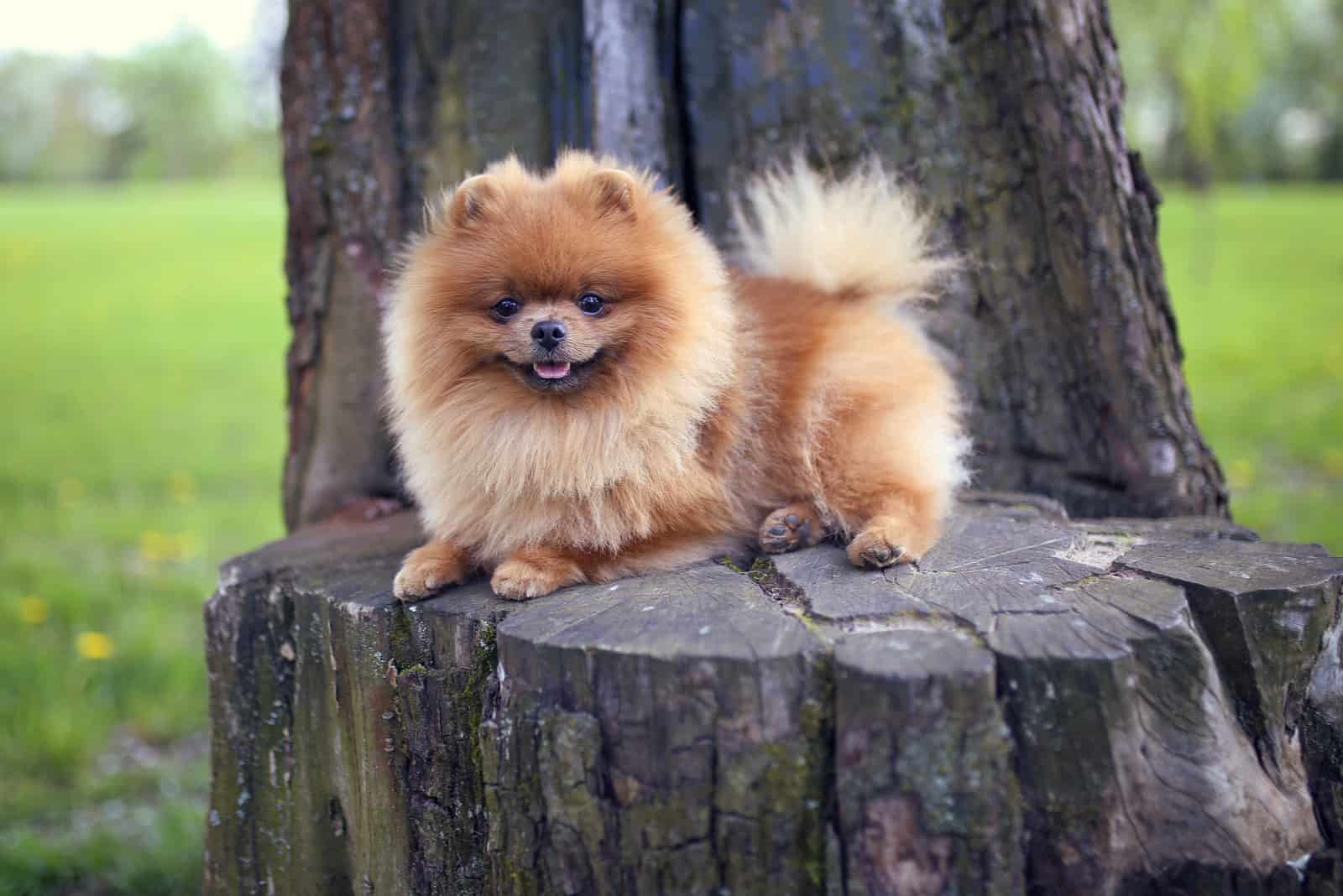Were you looking for Pomeranian colors other than orange and tan? You came to the right place because I gathered all of the beautiful Pom shades and patterns in this article!
These fantastic pups were very popular among the nobility throughout history, primarily because of Queen Victoria, who was a Pom enthusiast and bred these puppies during her life.
Pomeranians belong to the Spitz type of dogs, along with Akita Inus, Chow Chows, Samoyeds, German Spitzs, and others.
Poms come in an array of shades and patterns, from common, rich colors like orange or black to less-familiar, unique hues, like the beaver shade.
Without further ado, let me present you with the beautiful range of Pomeranian colors that will make you love these pups even more!
Pomeranian Colors
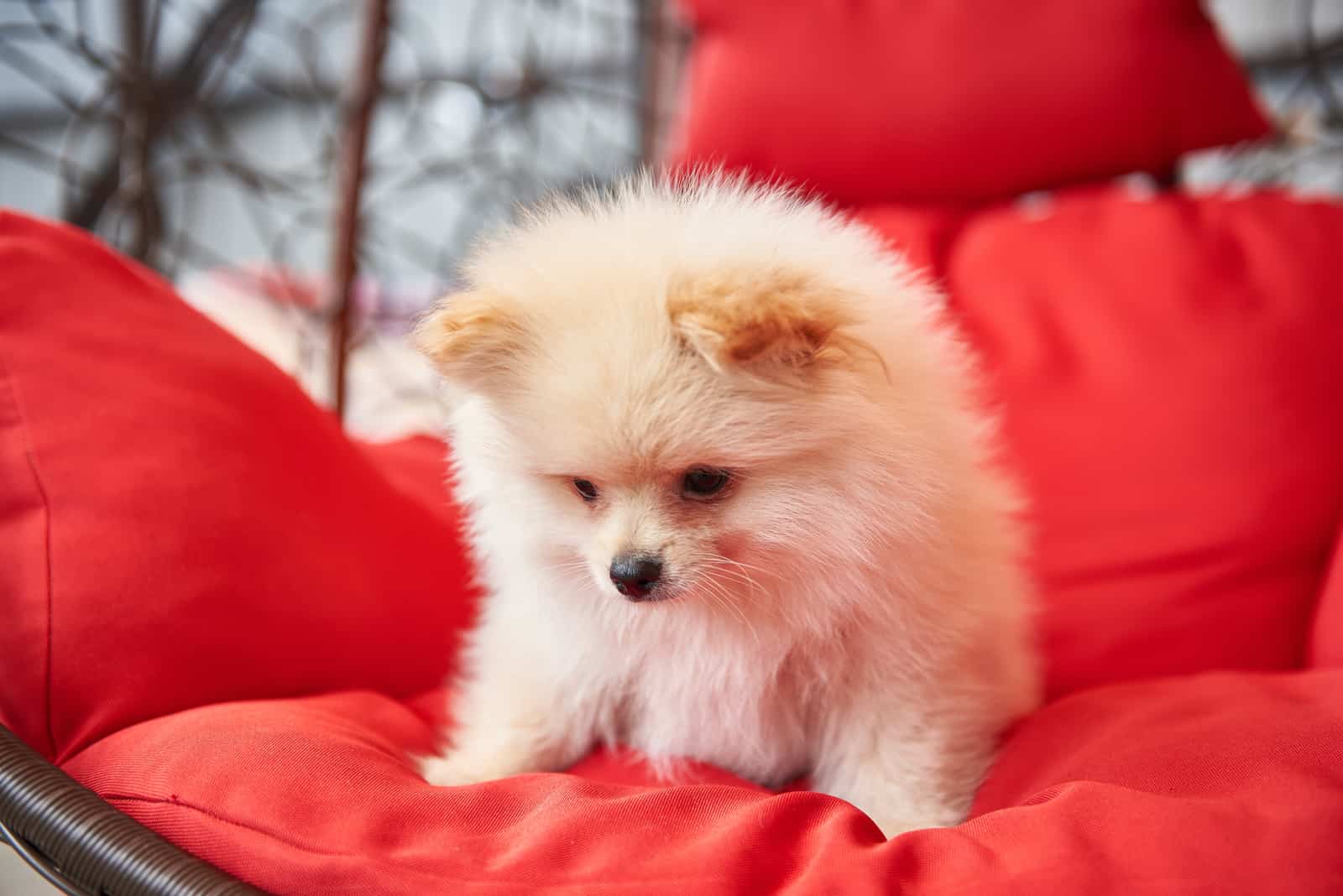
In the list below, you will find all of the Pomeranian colors that have been recognized up until now.
Some of these shades haven’t been acknowledged by major institutions, such as the American Kennel Club, but that doesn’t mean these shades don’t exist.
Even though some of the colors might not be suitable for dog shows, they’re more than welcome as family companions!
1. Black and Brindle
2. Cream
3. Chocolate sable
4. Merle and tan
5. Chocolate merle
6. Parti
7. Wolf sable
8. Black and tan
9. Cream Sable
10. Blue sable
11. Chocolate
12. Blue and tan
13. Blue
14. Blue brindle
15. White
16. Blue merle
17. Red sable
18. Beaver
19. Chocolate and tan
20. Black
21. Solid orange
22. Tricolor
23. Orange sable
24. Red
25. Lavender
Standard Pomeranian Colors
1. Black
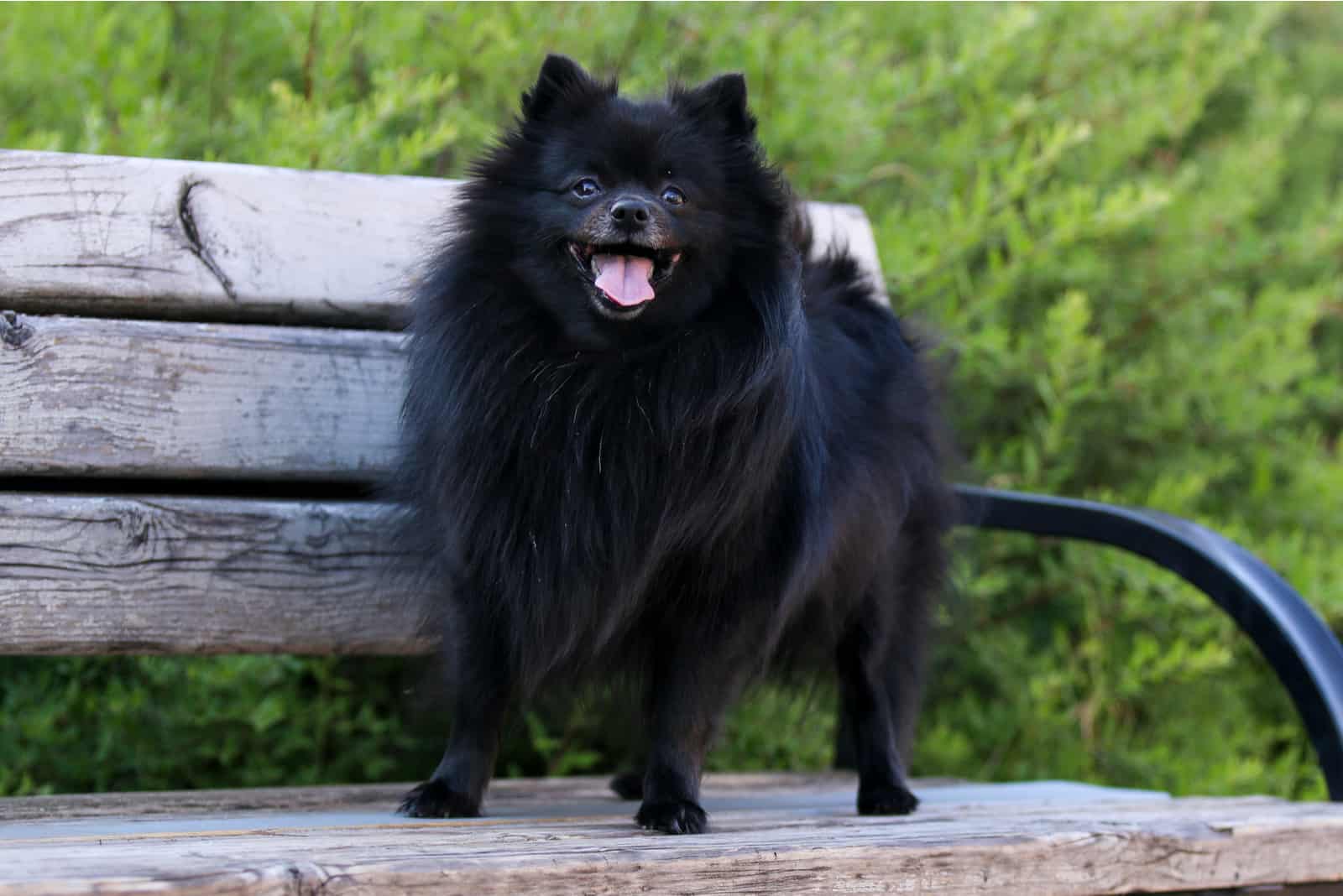
A black Pom is covered in solid black shade, including the undercoat and the guard hairs. According to the breed standard, no other color should be mixed with the black shade.
Therefore, black Pomeranians shouldn’t spend much time in the sun or else their black coat might fade into a reddish or pinkish color.
A few white hairs might appear in the chest area, especially in adult dogs, but that won’t have any impact on the overall look of the black Pomeranian.
2. Black And Tan
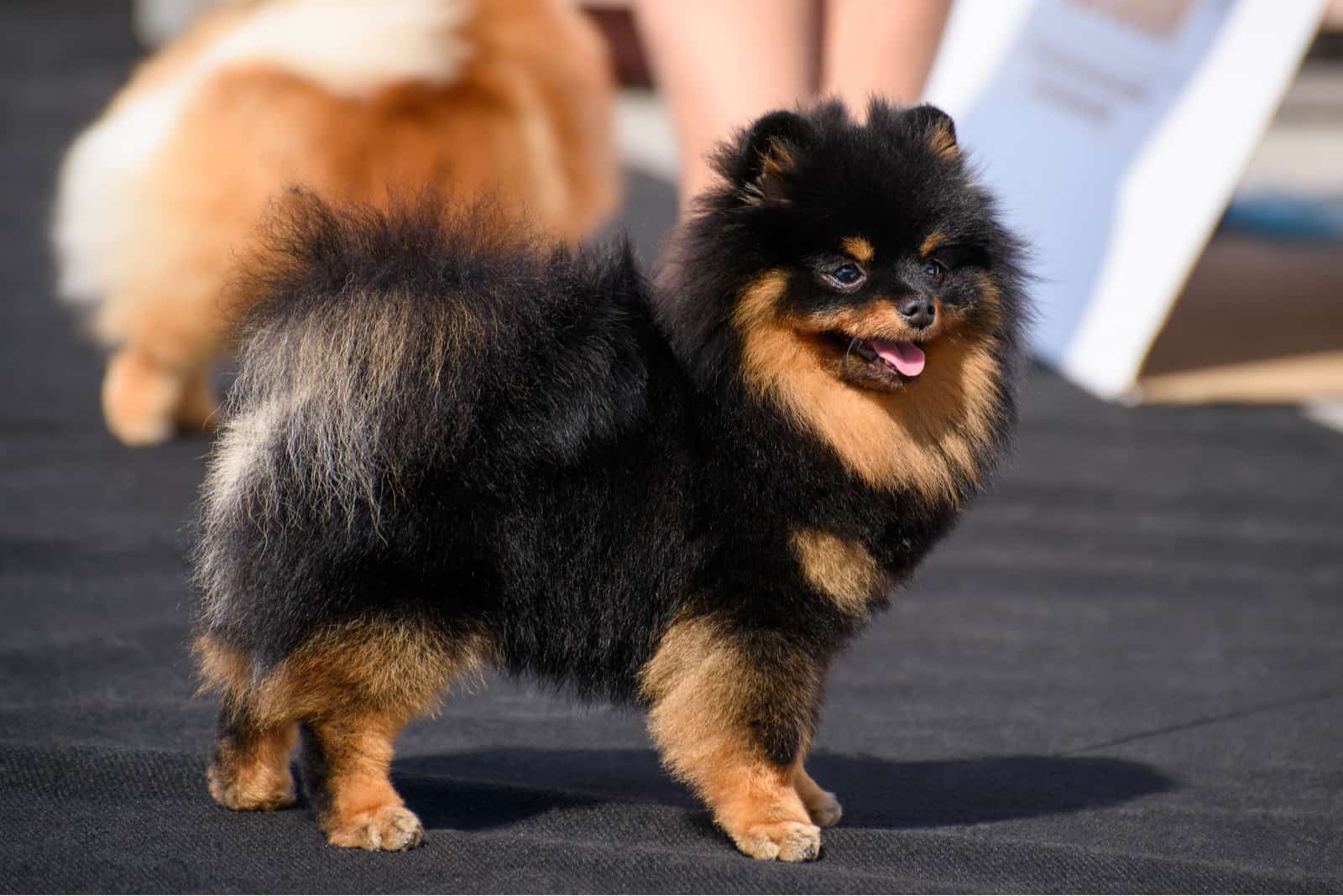
The best way to describe this type of coat color is to say that this is a black Pom with a rust-like or tan coat pattern that can be seen on the legs, head, chest, or neck of the canine.
Essentially, the top layer of the Pom coat is supposed to have a black pigment, including the muzzle and back, as well as their paw pads.
In conformation events, black and tan Pomeranians get a higher score if their tan markings are colored in darker shades rather than light tan spots.
No other color is accepted in this combination. If a Pom pup has a black and tan coat, with any part of the body covered in white or any other shade, it can’t be called a black and tan Pomeranian.
3. Blue
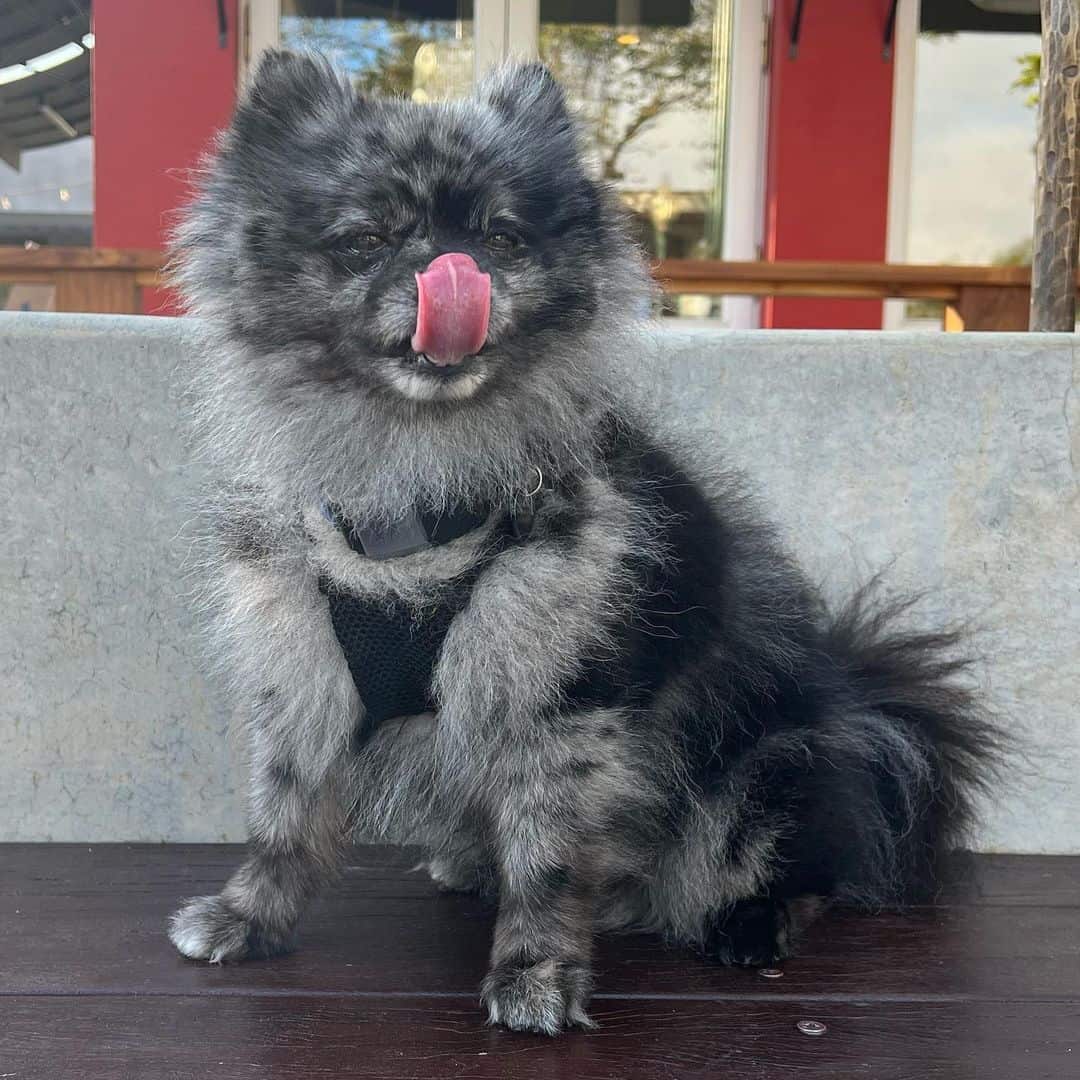
Photo from: @cookiesandkai
Although the coat color of these canines is named blue, the tone of the color is reminiscent of more silver or gray shades.
The majority of Pomeranian puppies come into this world with a coat that is a mixture of a blue undercoat, dark gray guard hairs, and a silver-like top coat.
However, after the first half of the year, the coat color of these pups changes into a pale blue hue.
Blue Shih Tzus are pretty similar to blue Pomeranians, so make sure you don’t mix them up, especially if you’re a first-time dog owner.
4. Blue And Tan
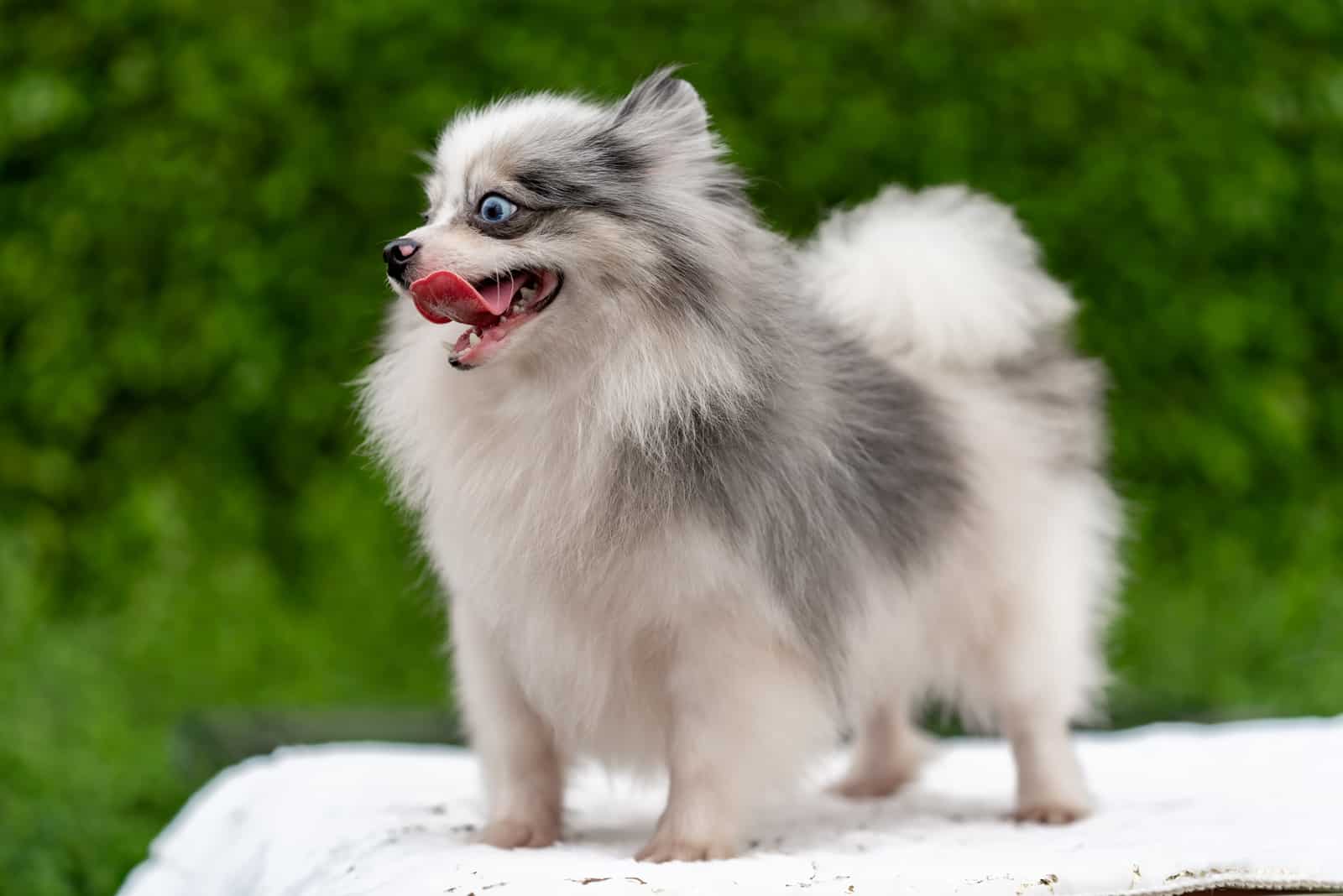
This pattern resembles the black and tan markings in a great manner. The only difference between the two is that the blue color covers the main part of the coat instead of the black.
Tanned lines usually appear on the neck, legs, head, and chest areas of the blue and tan pup. The term “tan” is quite broad, and can involve any hue from beige to an orange-brown mixture.
When it comes to the blue shade, it can also vary from a faded gray to a deep blue hue, depending on the canine’s genetic background.
5. Chocolate
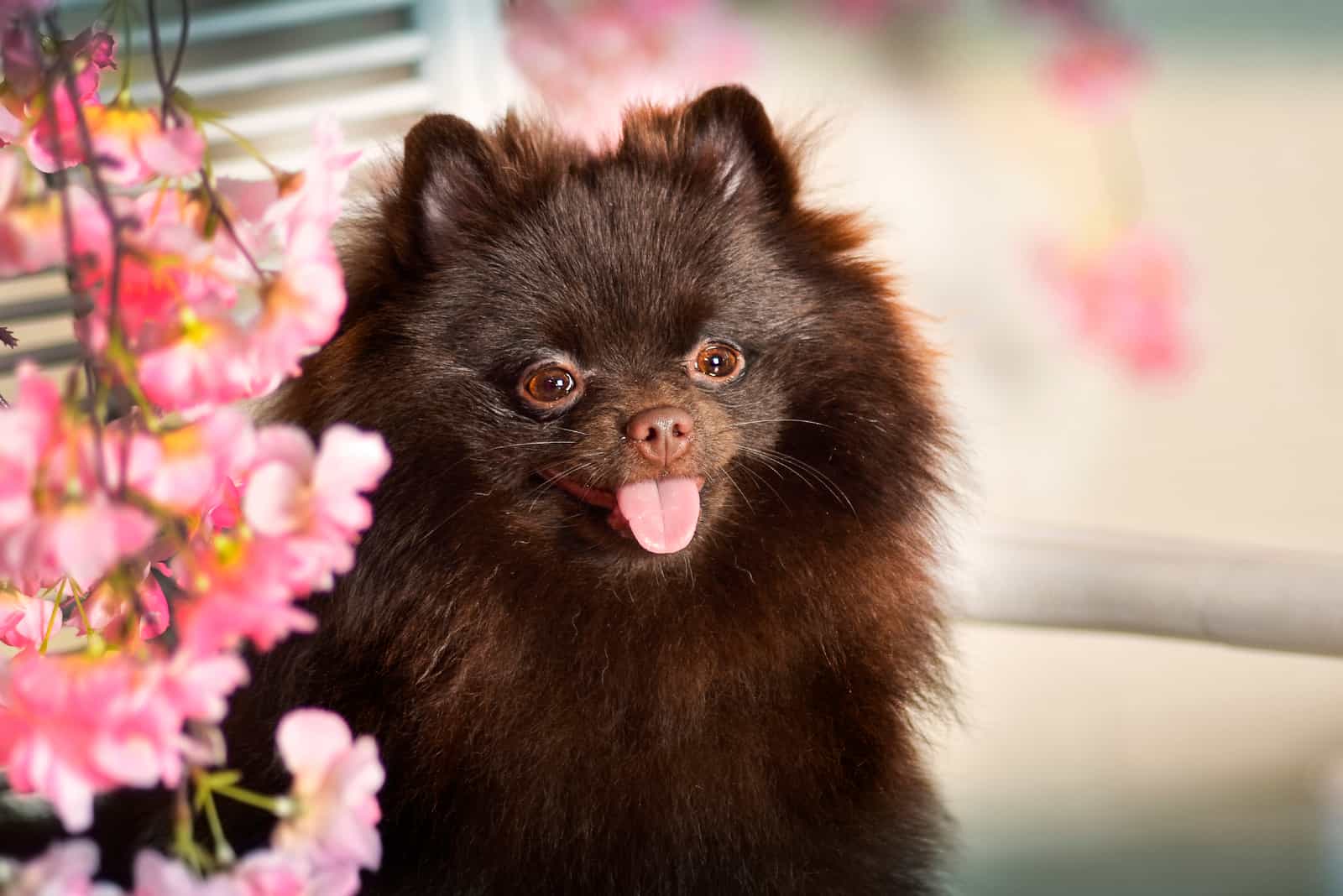
Choco Poms are sweeter than many things in this world, including chocolate! These brown pooches look simply adorable, with a strong coat color and brown eyes.
According to the standard, the chocolate Pomeranian’s coat is supposed to be brown only, without any other shade on any part of the body.
When it comes to the eye color, it’s usually brown as well, but it can vary from hazel to a dark brown shade.
Chocolate Poms shouldn’t be exposed directly to the sun or else their coat might turn into a reddish hue rather than its vivid brown color.
6. Chocolate And Tan
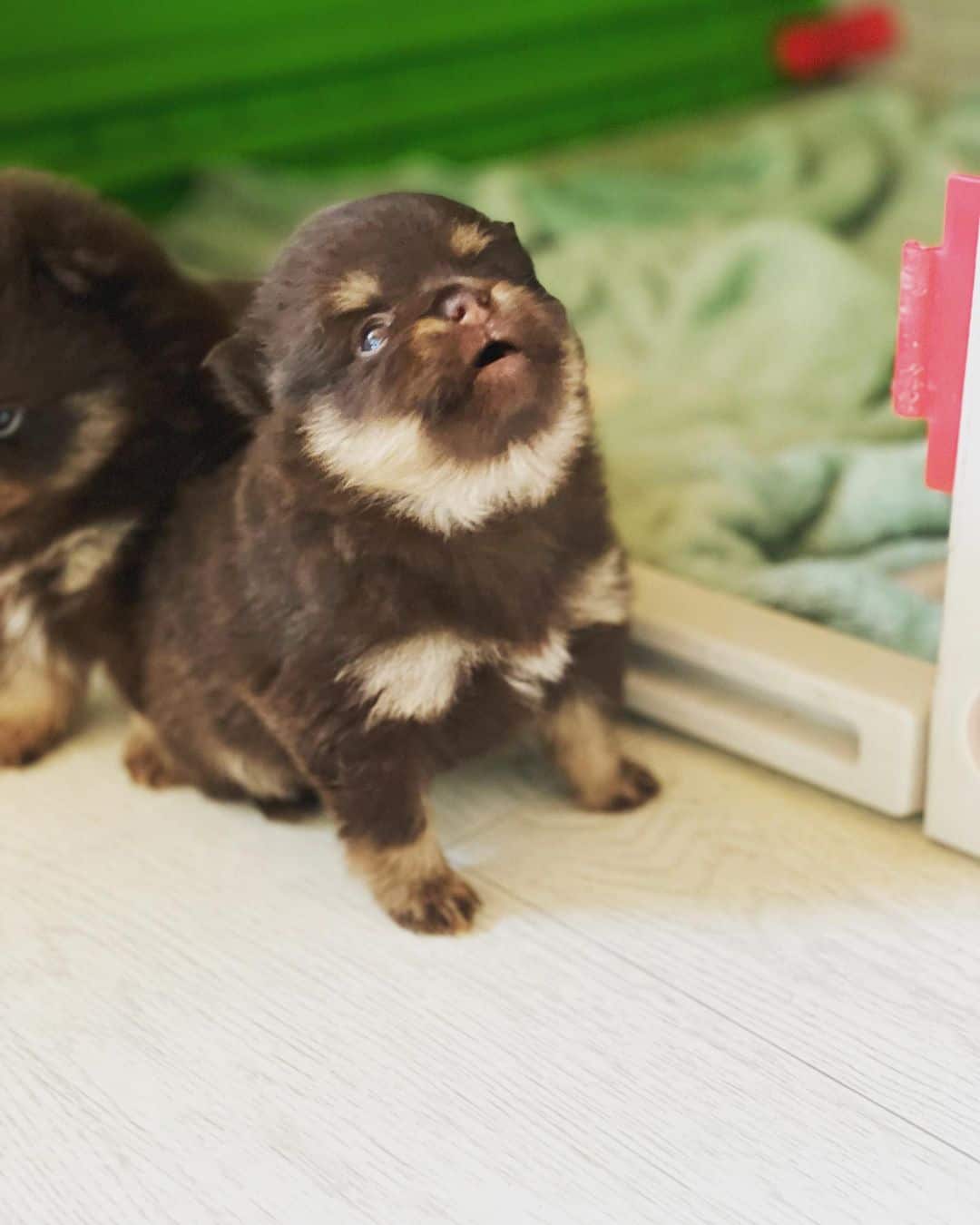
Photo from: @little_sparkling_diamond_poms
All Pom pups are referred to as chocolate and tan if they have a blend of lighter and deeper brown shades as a part of their coat.
In contrast to tri-color canines, these doggies do not possess any other shade marks on their body.
The chocolate and tan markings follow the same tan pattern as in other colors. The majority of the coat is covered with a bold brown shade, while the tan lines appear in the chest, legs, head, and tail areas of the Pomeranian’s body.
Another thing that makes these pups even more adorable is the massive mane that spreads out all around their head, which is why they appear even fluffier!
7. Cream
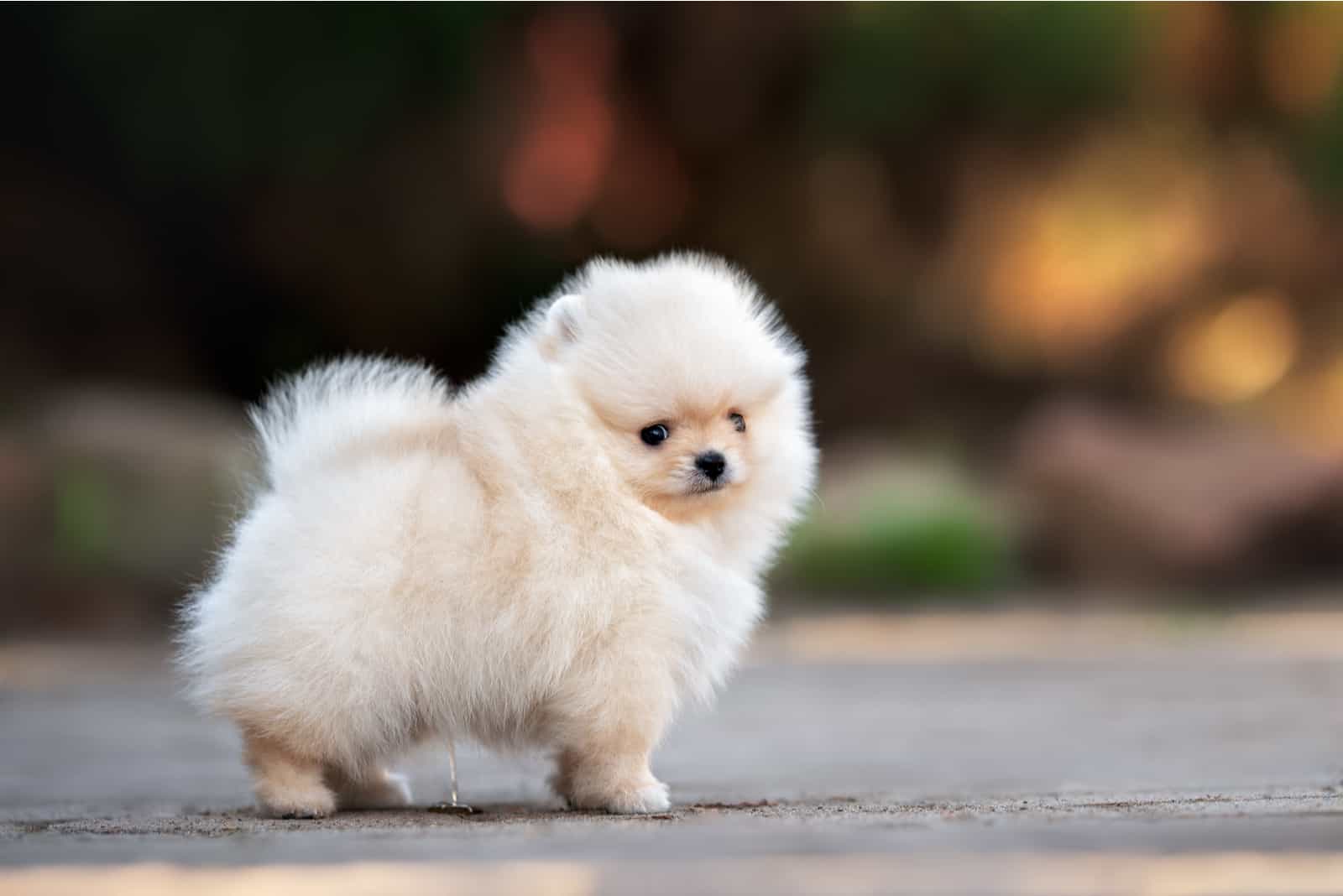
As you can see, Pomeranians can come in a variety of colors and patterns. Cream is one of the most common color types you can come across, not only in Pomeranians, but in other dog breeds, such as the English Cream Dachshund.
Creams have a hue that is somewhere between washed-out brown and orange shades, faded out to the point that it looks light beige.
Cream Pomeranians are born white in most cases, but their coat color changes as they grow older. A lot of people confuse these pups with white Poms, so if you’re not sure about the color, it would be better to wait and see whether the cream shade will appear in certain parts of the pup’s body.
8. Cream Sable
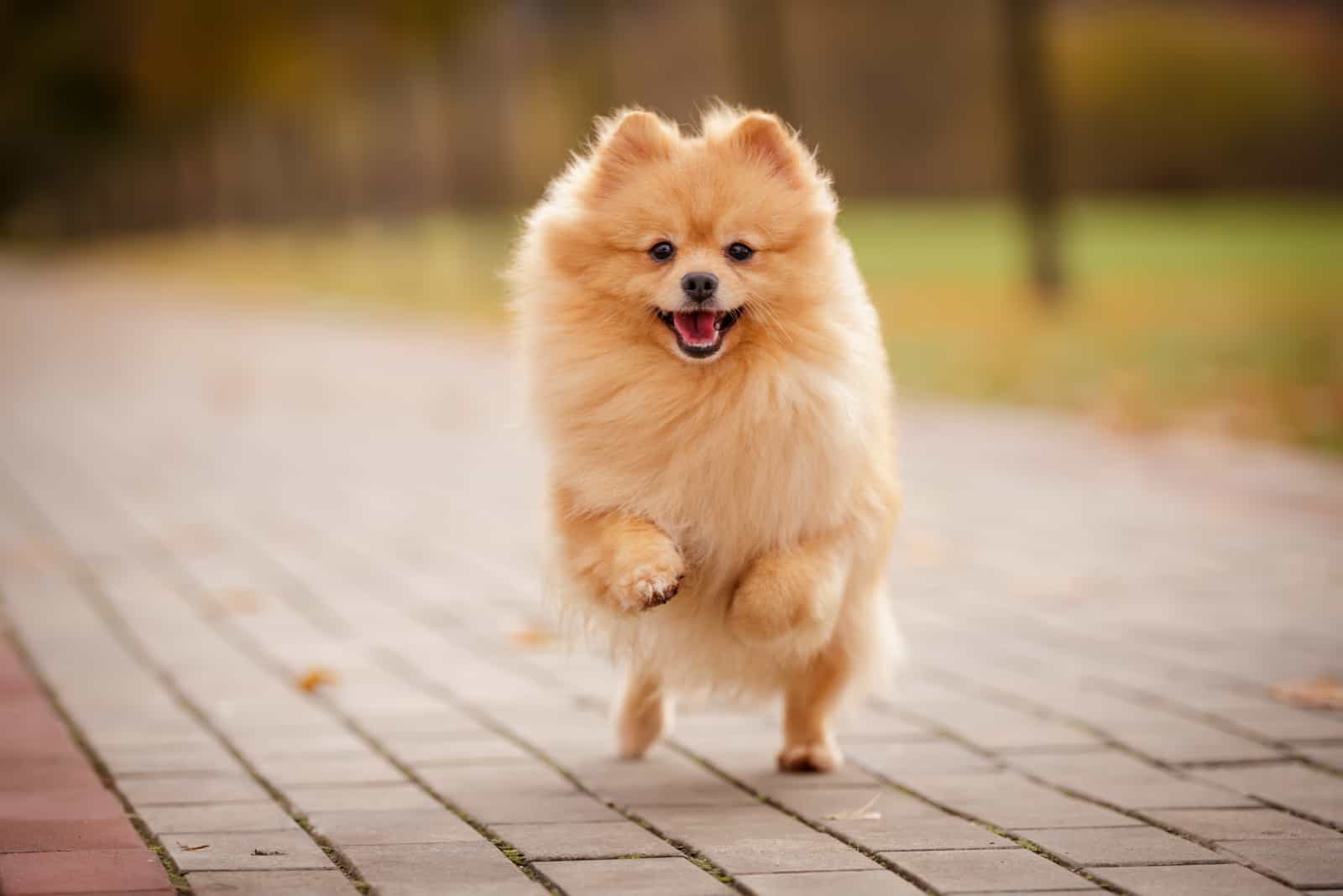
This color is considered one of the most beautiful shades of a Pomeranian’s coat.
An absolute treat to take in is the striking distinction between the cream undercoat and the spiky guard hairs, which, when paired with the big black points and same-color eyes, is a beautiful sight.
During the first few months of life, cream sable Pomeranians actually have a silver type of coat shade, which turns into a cream hue with black tipping at the top of the guard hairs.
9. Orange
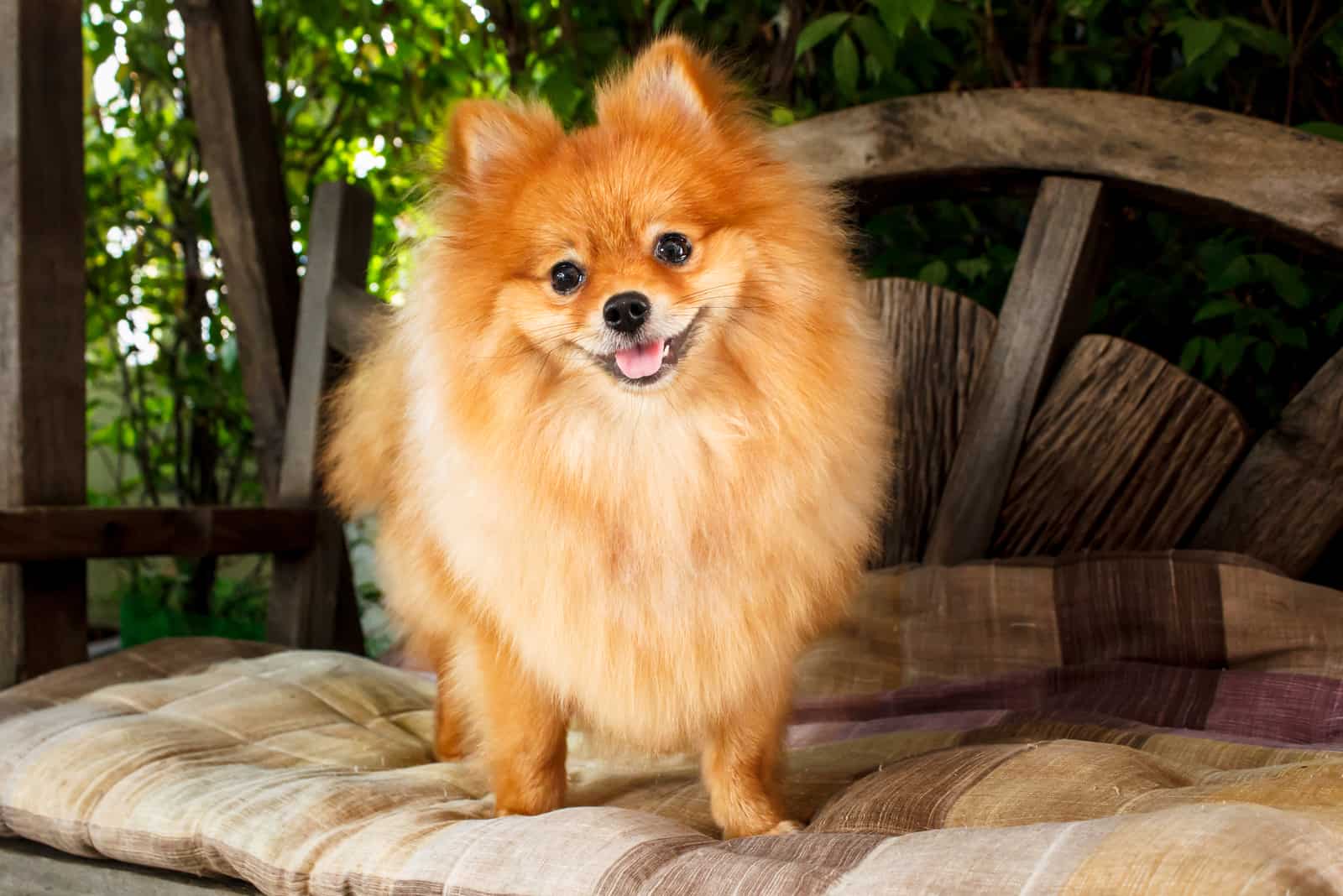
This is by far one of the most popular Pomeranian colors that range from a soft orange shade to a strong, deep orange color.
One of the most common misconceptions about this color is that it is a tan color, even though these pups are technically recognized as orange Pomeranians.
According to the breed standard set by the American Kennel Club (AKC), orange Poms should possess a black nose, mouth, pads, and eyes.
It’s interesting to notice that the orange color can be inherited from either of two different genetic backgrounds.
One type of orange Pomeranian is born with a kind of sable pattern that turns into solid orange as they become older, while the other type stays in solid color from birth to adulthood and beyond.
These pups are in high demand not only in the U.S., but in Canada as well.
RELATED: The 5 Best Pomeranian Breeders In Ontario Of 2022
10. Orange Sable
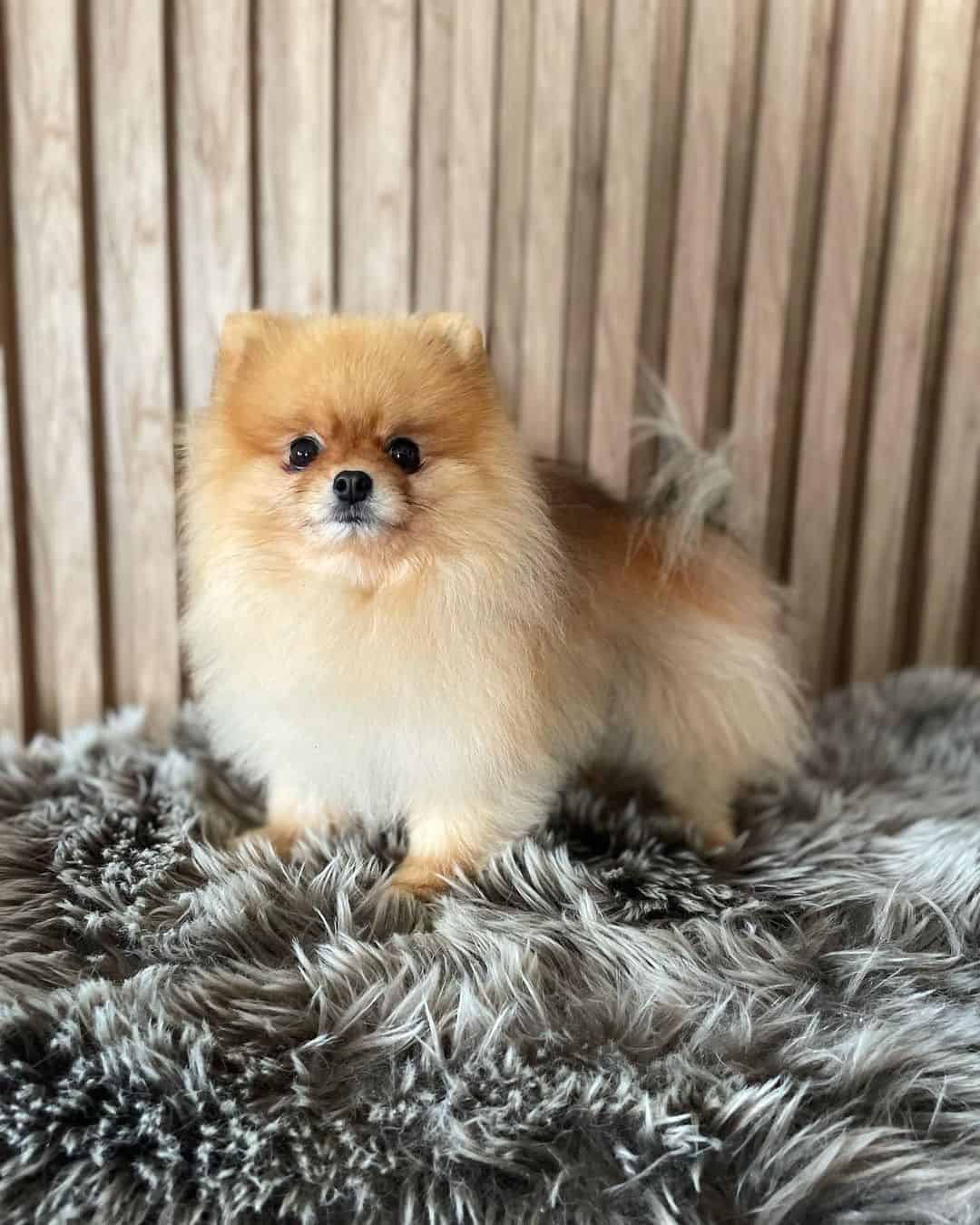
Photo from: @fluffyrodinka
The dog’s coat is covered with dark marks, which gives the impression of black stripes running across the coat hair.
Some people might mix them up with cream sable pups, but once you notice how deep the orange is in contrast to the cream hue, you’ll never make that mistake again.
In terms of eye rims, mout, pads, and nose – orange sables follow the same color scheme as solid orange Poms.
11. Red
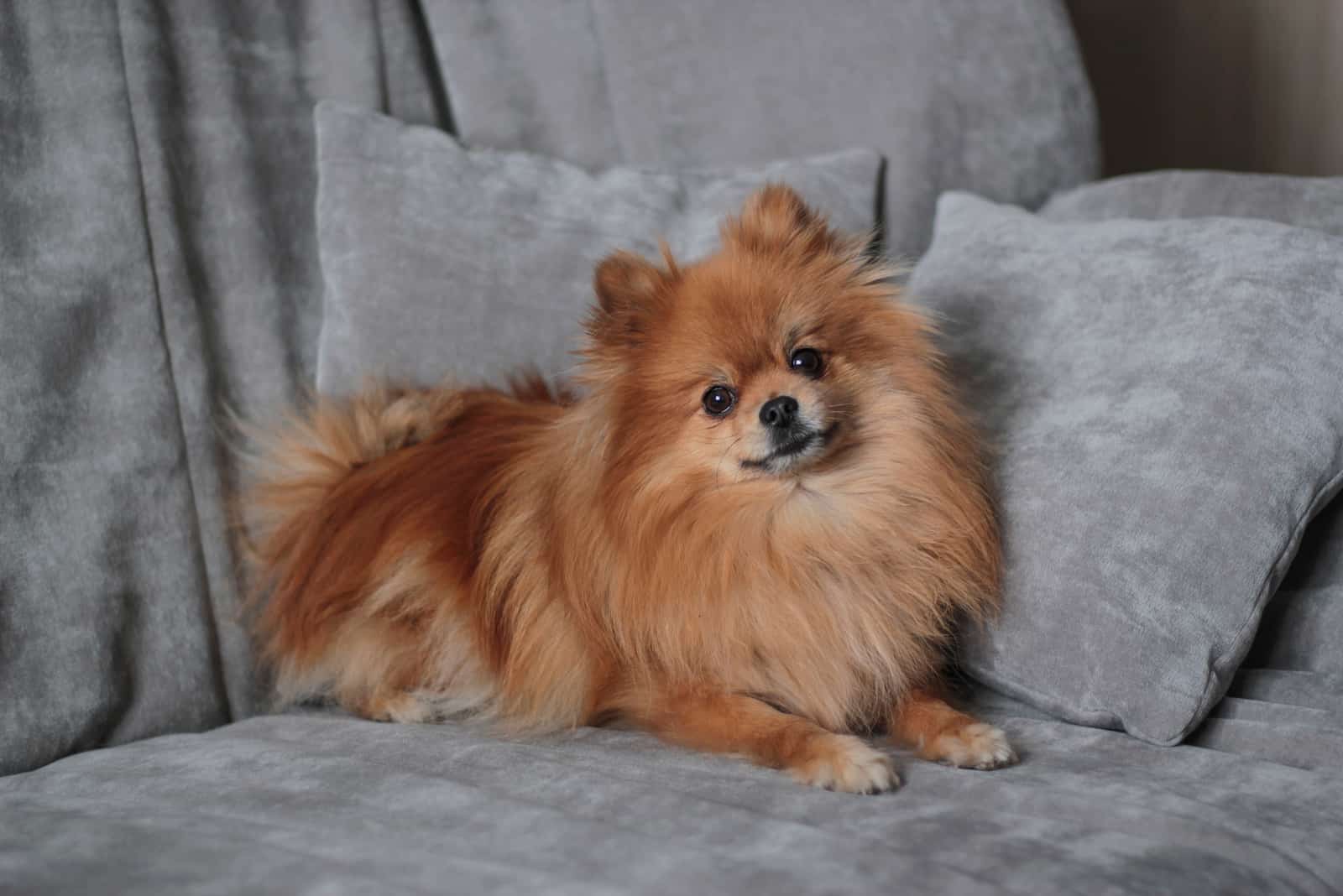
The first thought you might have about this coat type is that it looks a lot like orange, which is true, but they’re still not easy to mix up, at least not like tan and orange shades.
A red Pomeranian has a deeper and stronger hue, becoming even more apparent after the first few months of the pup’s life. Some pooches might have pale red at birth, but the color goes deeper as they grow older.
There should be no doubt about which one is which; in case you’re not sure about the color, there’s a 99% chance you’re looking at an orange Pom.
Oranges are far more prevalent than their red counterparts. However, red color isn’t that uncommon among dog breeds in general, such as:
• Corgis
• Poodles
• Irish Setters
• Vizslas
• Rhodesian Ridgebacks
• Fox Red Labradors, etc.
READ NEXT: Top 5 Best Fox Red Labrador Breeders In The U.S.
12. Red Sable
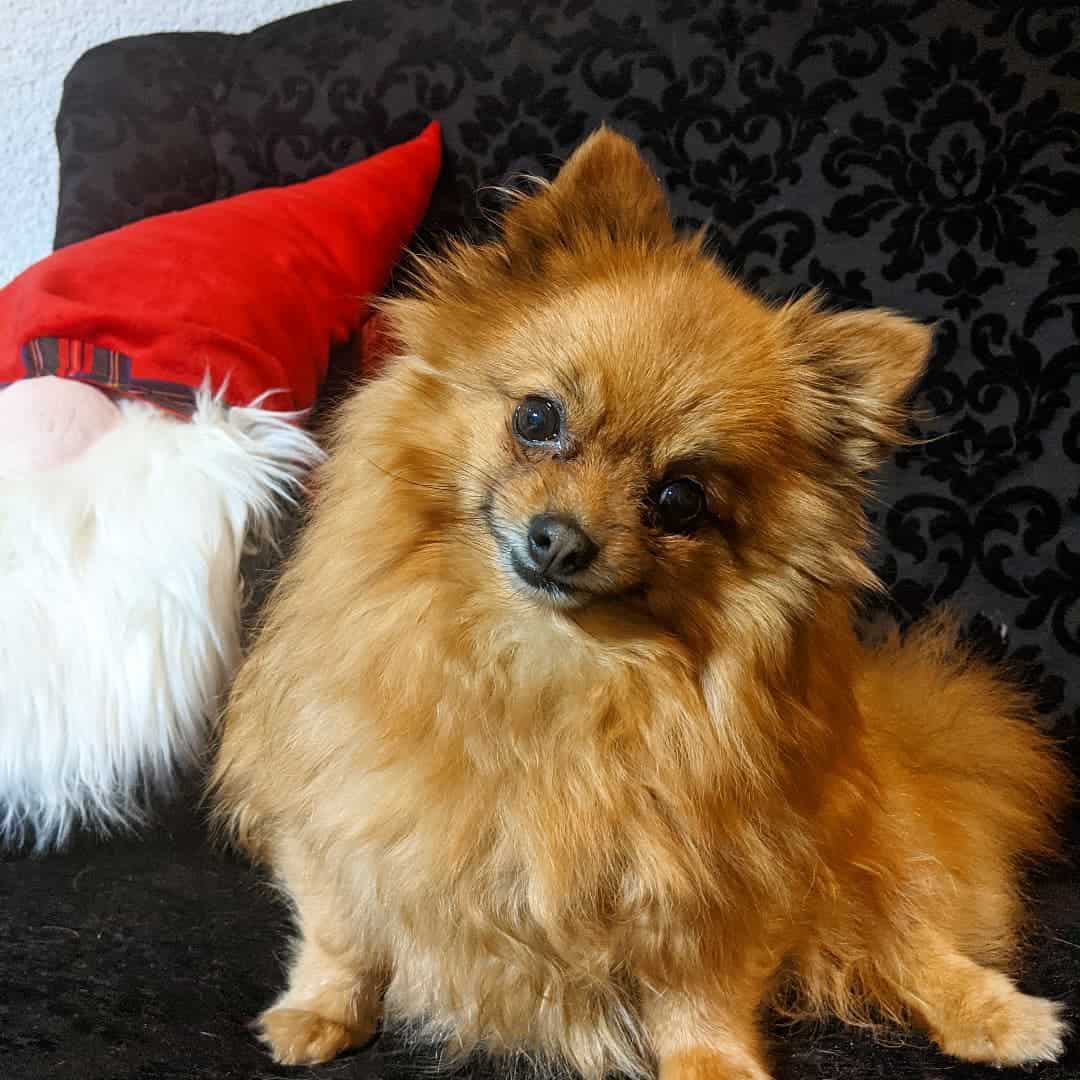
Photo from: @luxuryhighclasspomeranian
A red coat marks this type of coat color and pattern, with black tips on the top of the coat hair.
These specks of black color can be noticed easily as they provide the coat with a beautiful dust kind of look.
This type of pup has rich, red-colored coat hair with sable stripes, which add to the rusty look of the red sable Pomeranian.
This Pom’s eyes are almost always a shade or two darker than chocolate hue, while the coat hair that is placed around the mouth, eyes, and chest is a shade or two softer than red.
This color reminds me of the Irish Setter’s coat quite a lot, although the Setter doesn’t have any black hair, not even on the tips.
13. White
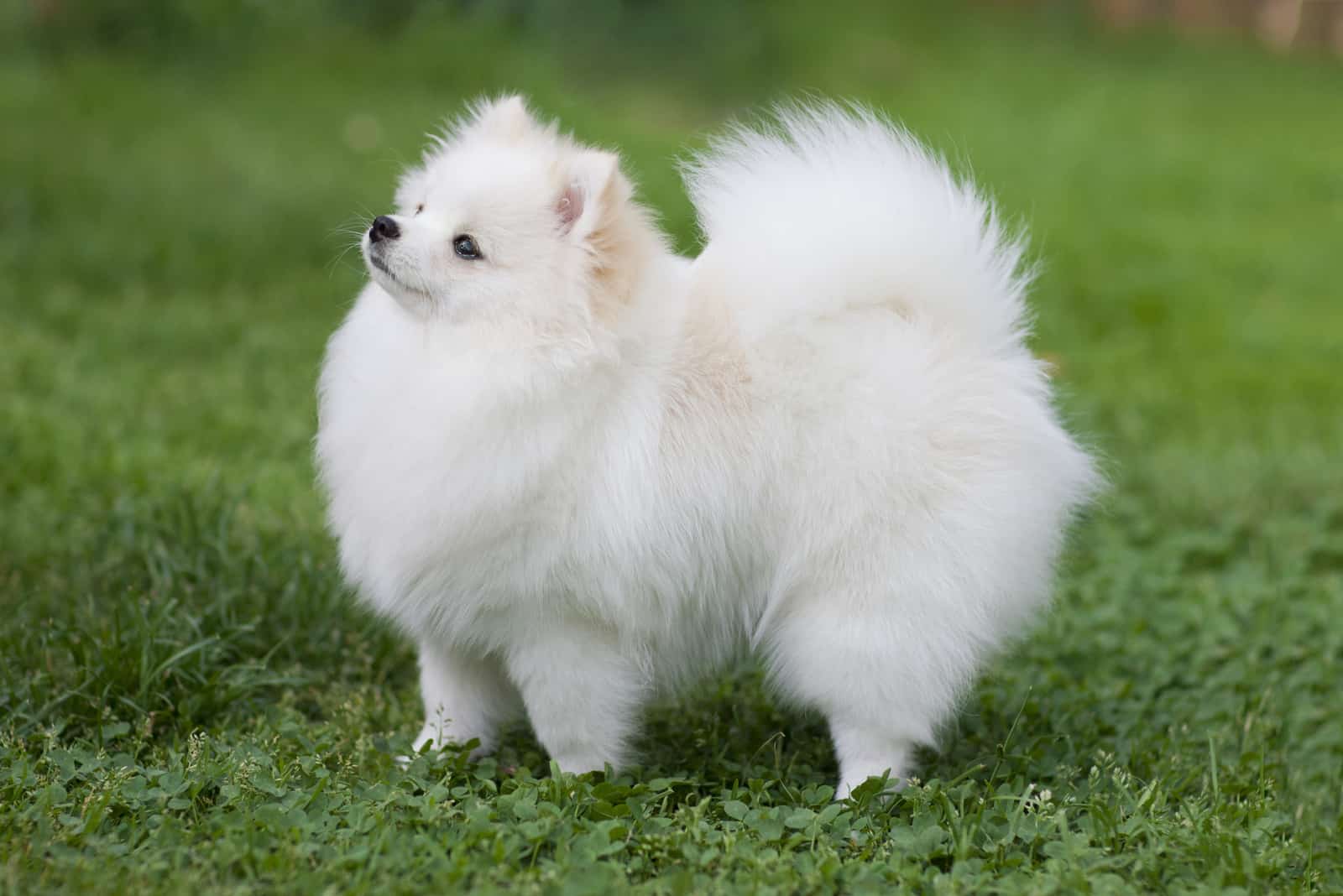
This is one of the Pomeranians that can’t go unnoticed because of their pure white shade, which makes them look like Maltese pups or mini versions of white Samoyeds!
They may not be as uncommon as white Chihuahuas or white Shih Tzus, but they’re not as popular as white Poodles either.
White Pomeranians are small dogs with an entirely white coat, free of any other tone or shade. There will be no hints of orange, lavender, black, blue, or any other hue at all, nor will there be any part with cream colorations.
Even a hint of another shade on the white coat is a sign that the Pomeranian’s coat is rather cream than pure white.
This is also one of the rare canine breeds that has a solid white coat, and that doesn’t have any health issues as a consequence of being born with the white coat shade.
Some experts claim that most dog breeds with solid white color (no white markings on the coat) are at a higher risk of skin problems or hearing impairment, which might lead to deafness.
14. Parti
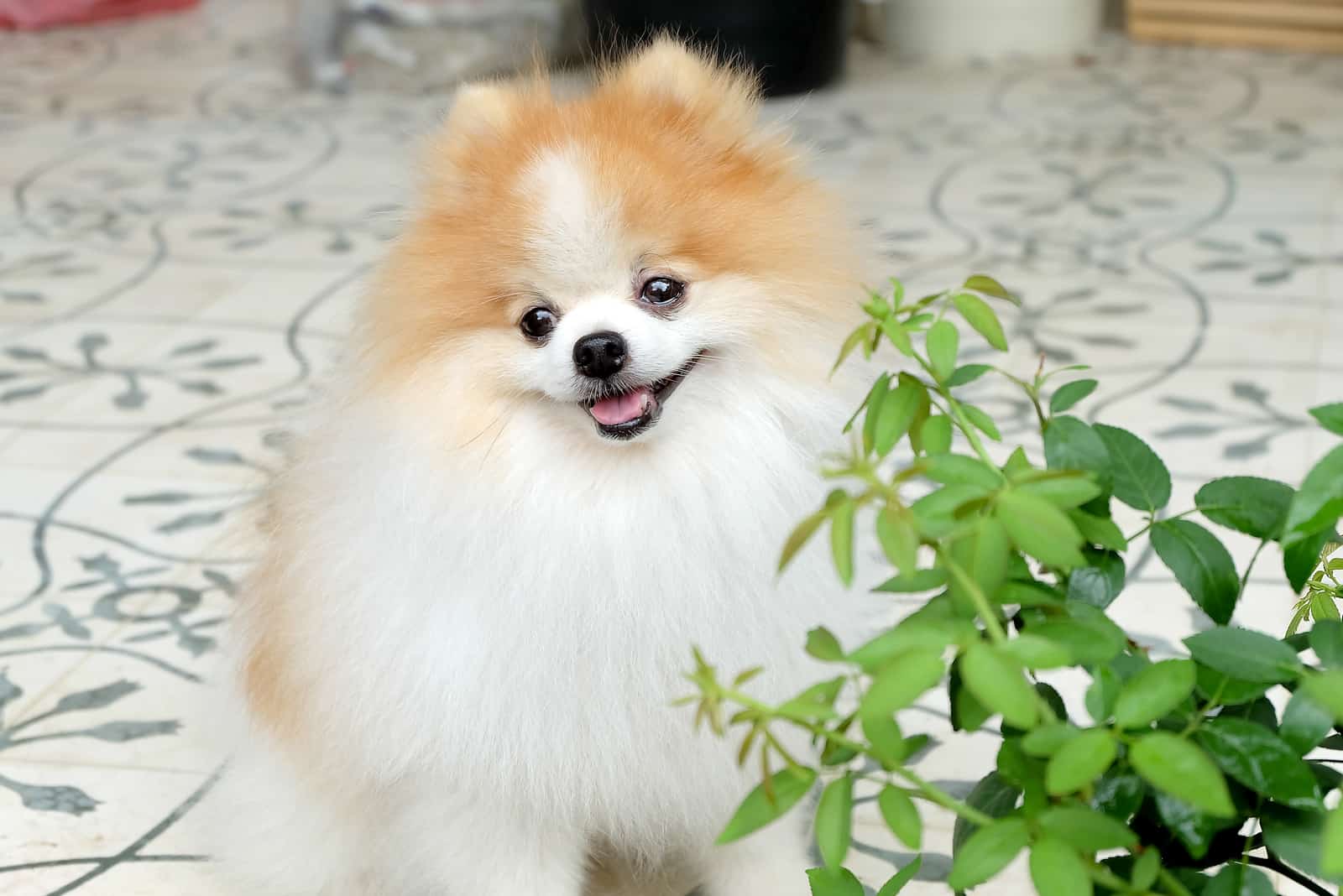
This type of coat is characterized by a white base coat that is combined with a single shade (black, brown, red, etc.) or a single pattern (sable, merle, or brindle).
The majority of the spots will be found on their head, back, and occasionally, on their paws.
Parti Pomeranians are very popular among canine owners and breeders.
Parti Poms can be divided into three types, according to the breed standard:
• Extreme Piebald – Most of the body is covered in white shade, while the rest is colored in a different shade.
• Piebald – Half of the body is colored in a white hue, and the other half is in another shade.
• Irish Piebald – This Pomeranian has a single shade on the top of its head. The shades that might appear are black, cream, blue, white, orange, or even lavender (not recognized by the AKC), while the rest of the Pomeranian remains white.
The AKC prefers at least half of the Pomeranian’s body to be white, but they do accept even those with less white on their coat.
15. Wolf Sable
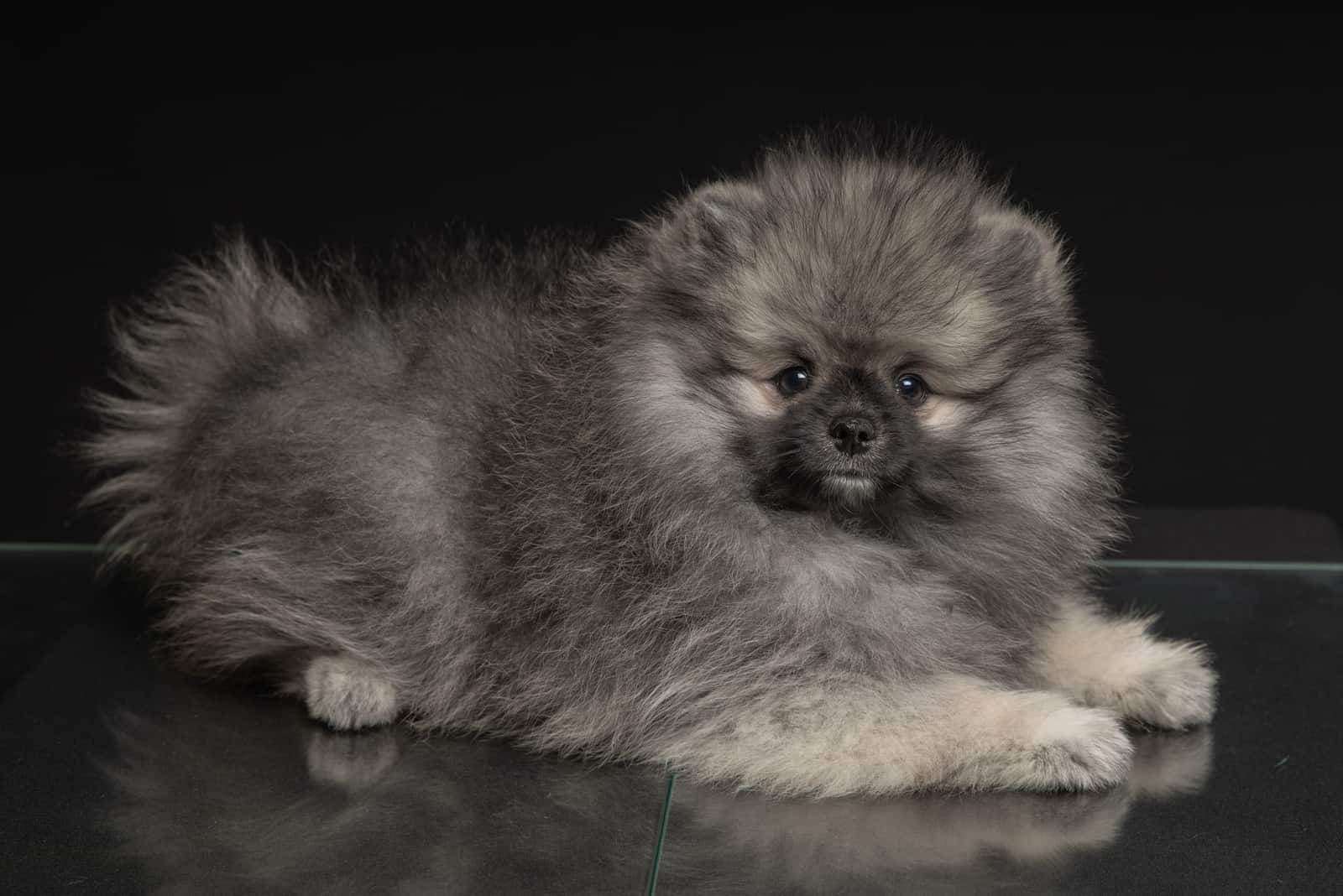
Just like the name says, this type of Pomeranian coat makes the doggie look like a true wolf, but a charming little one!
The wolf sable canine is generally covered with a gray shade, but the top of the coat is sprinkled with either black or a silver-gray hue, which actually gives the impression of a wolf.
The eye rims are black in most cases, which is why they’re easy to distinguish from other sable types, and this makes it simple to detect them within a group of sables.
A wolf-sable Pomeranian is considered uncommon among Pomeranian colors, which is why they’re a bit pricier. Be careful when buying this type of puppy as some people might offer orange sable pups as wolfies before they turn colors.
16. Beaver
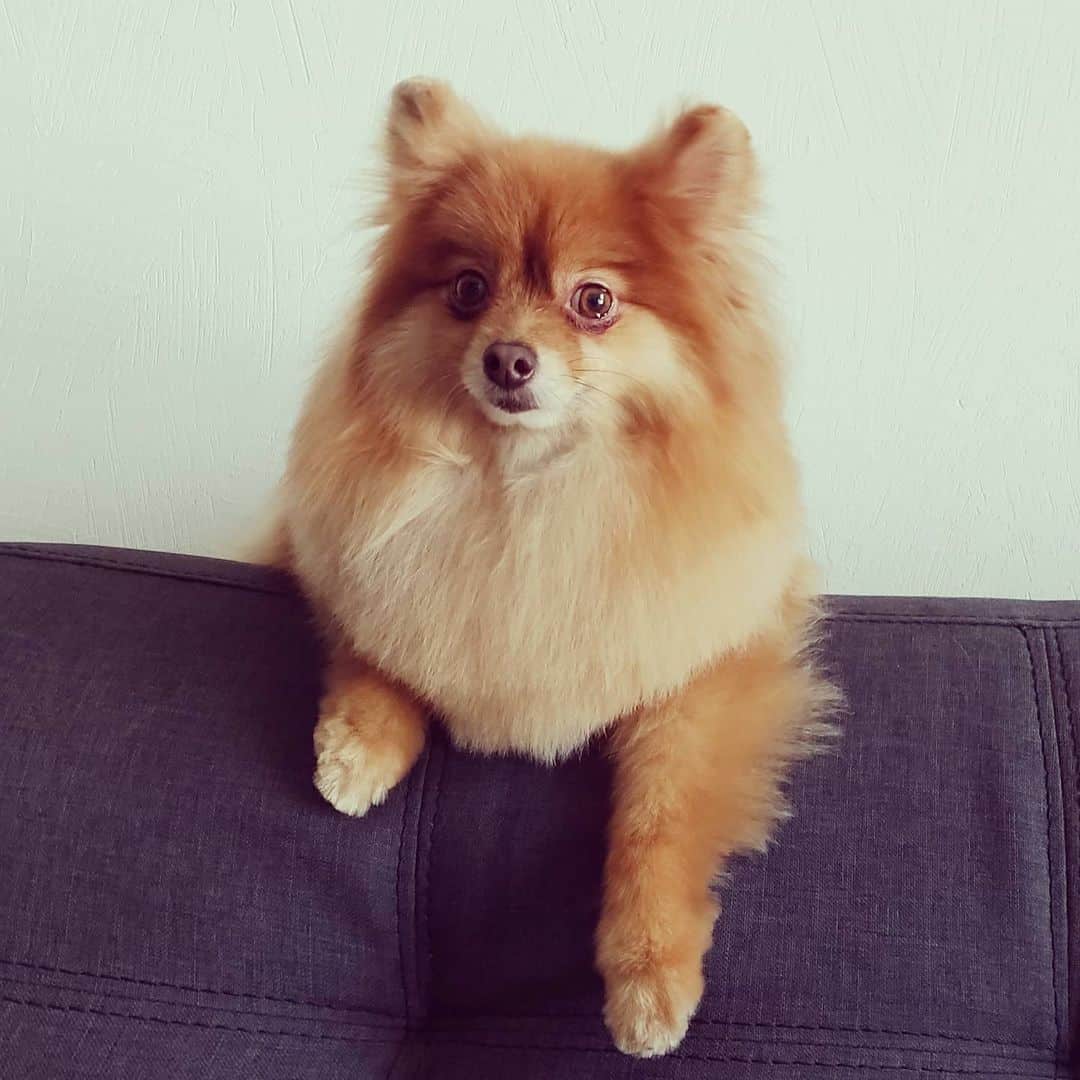
There are two reasons why these pups are popularly named Biscuits. The first one is that they’re as sweet as the most delicious cookie, and the second reason is their color, which is between a cappuccino cream and an orangey-brown.
In most cases, the tips of their hair will have a tint that resembles a metallic blue or silver shade.
A canine with a beaver coat usually has hazel or light brown eyes. No beaver Pomeranian comes with eyes in darker shades or black markings on its coat.
This is one of the rare canine breeds that includes the “beaver” color in the AKC’s breed standard. Therefore, if you like this type of brown shade, as well as dog shows, why wouldn’t you go for a beaver Pomeranian?
17. Tricolor
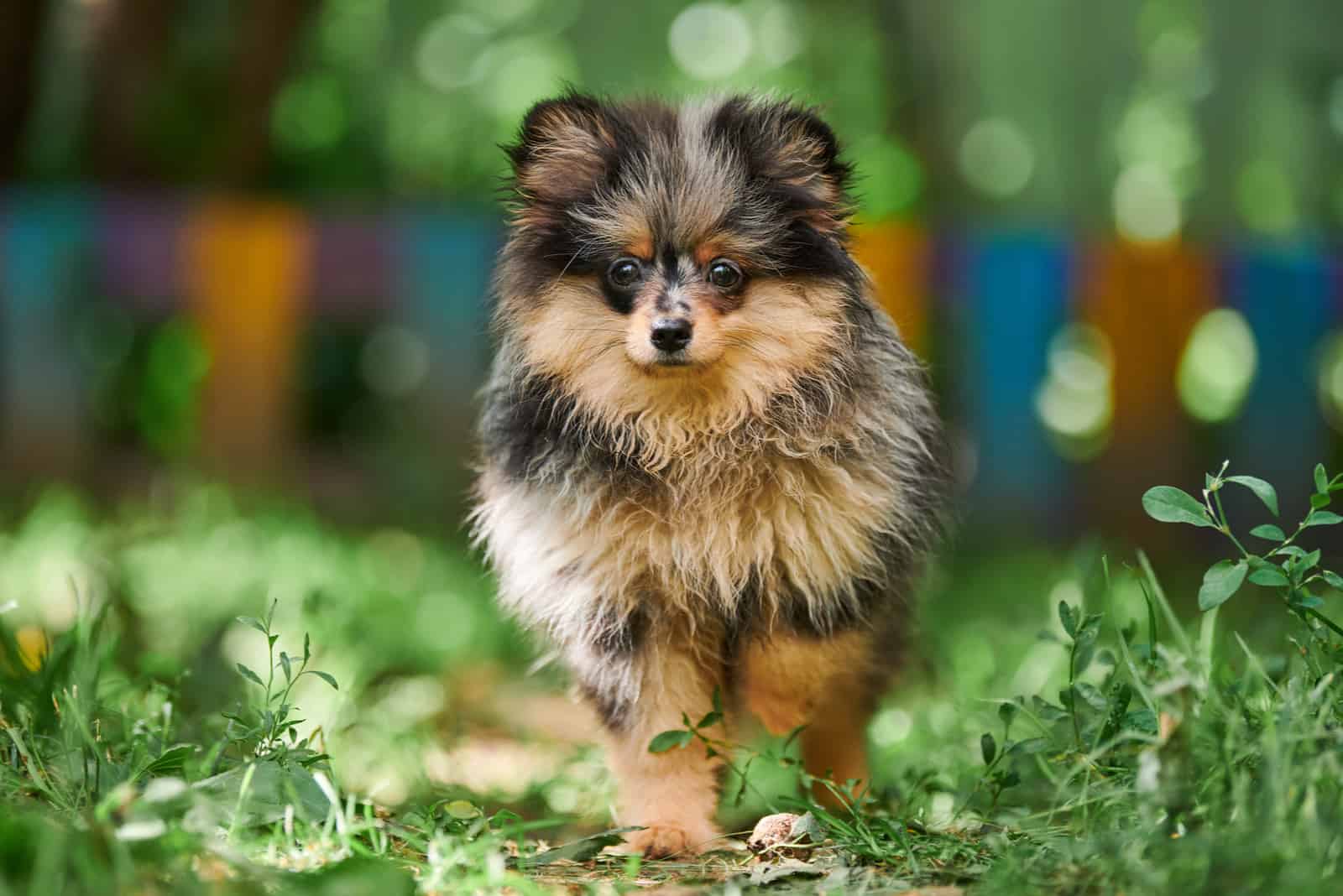
This is one of the most interesting colors of Pomeranians, or better to say, a combination of parti-color and tan Poms.
Tri-colored Pomeranians have three different shades on their coat, and they’re still acknowledged by the AKC (although this probably wouldn’t be their first choice as they prefer solid colors).
Tricolor Pomeranians have a white undercoat that is covered with spots of a specific shade or pattern, along with tan speckles, which aren’t limited by size or shape.
One of the most common shade combinations is white, with black or dark chocolate markings and tanned spots.
This type of coat hair can occur among many canine breeds, including Pitbulls, Beagles, Basset Hounds, Australian Shepherds, and others.
18. Blue Sable
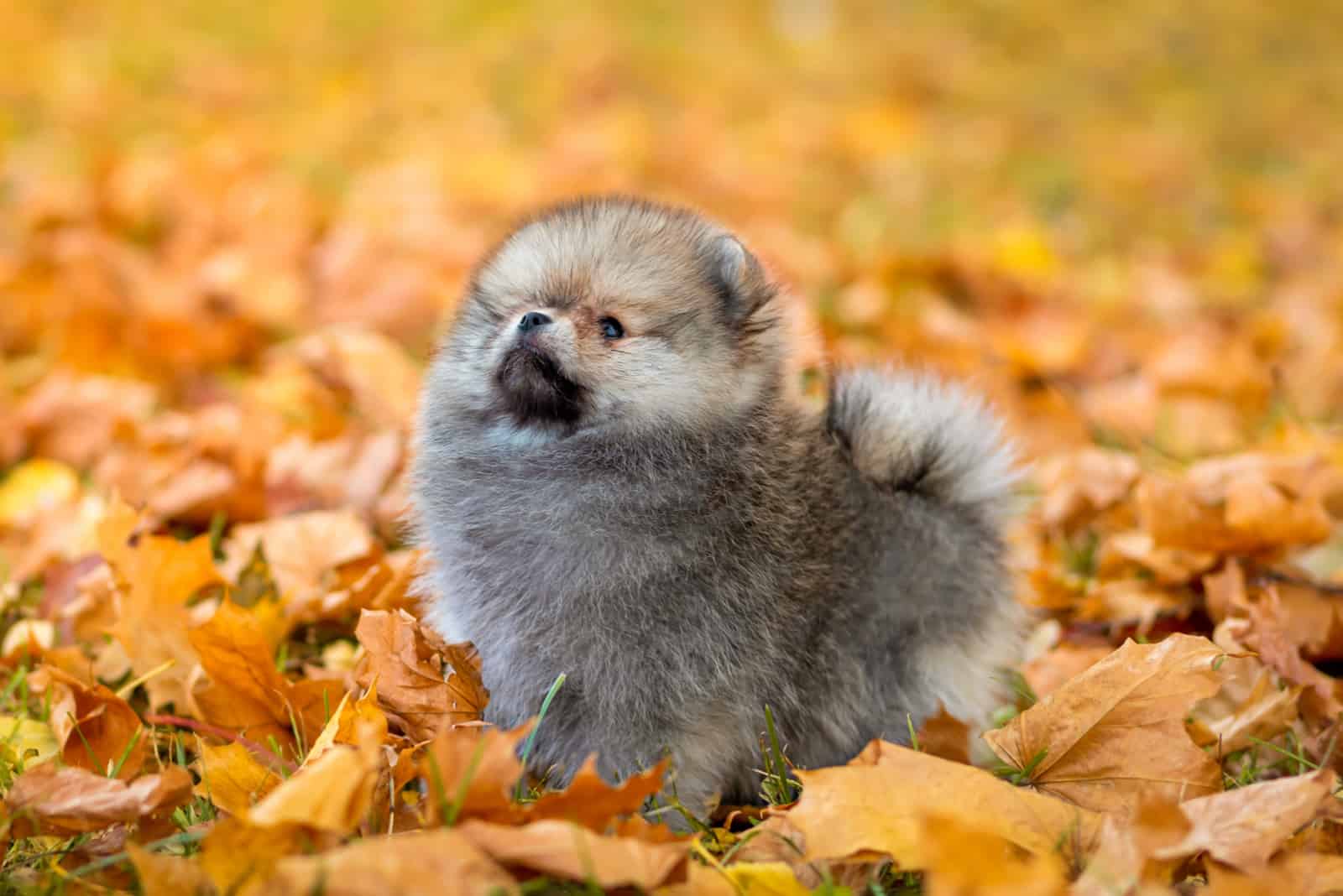
Many would probably agree that blue sable Pomeranians are the rarest of all coat types, and that wouldn’t be completely untrue.
Although they’re quite rare, there’s one shade that is truly unique for Pomeranians, which will be discussed later. However, blue sables are pretty uncommon themselves.
As you can already guess, the base color of this canine is blue, which turns to a darker shade of blue up until the tips of the hairs end in a black hue.
This type of coloring makes the blue sable look like a shadowy color, and all the fluff of the coat hair softens the coat’s border lines.
Regions that encompass their nose, eyes, and muzzle areas are often black, but their chest, tail, and paws are typically silver in color.
The sable pattern has to be consistent in color and markings, just like in other sable breeds, such as German Shepherds or French Bulldogs.
19. Chocolate Sable
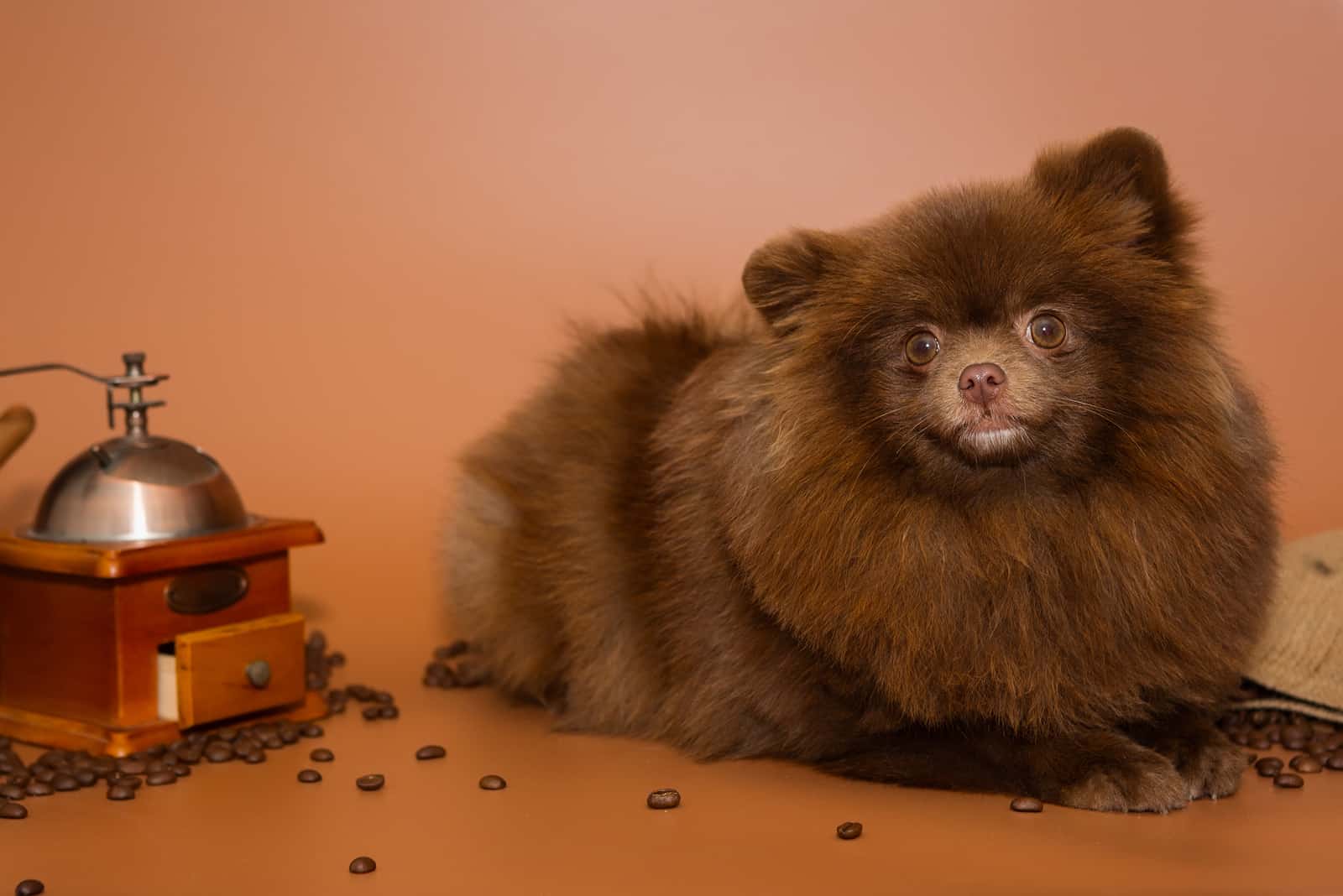
Essentially, this type of coat is the same as every other sable pattern.
Choco Poms that have a sable pattern are brown-coated pups with dark tips of the coat hair, which makes their color deeper than that of regular chocolate Pomeranians.
This pattern gives chocolate Poms a distinctive look that makes them stand out from other brown-like pooches.
Rare Pomeranian Colors
1. Chocolate Merle
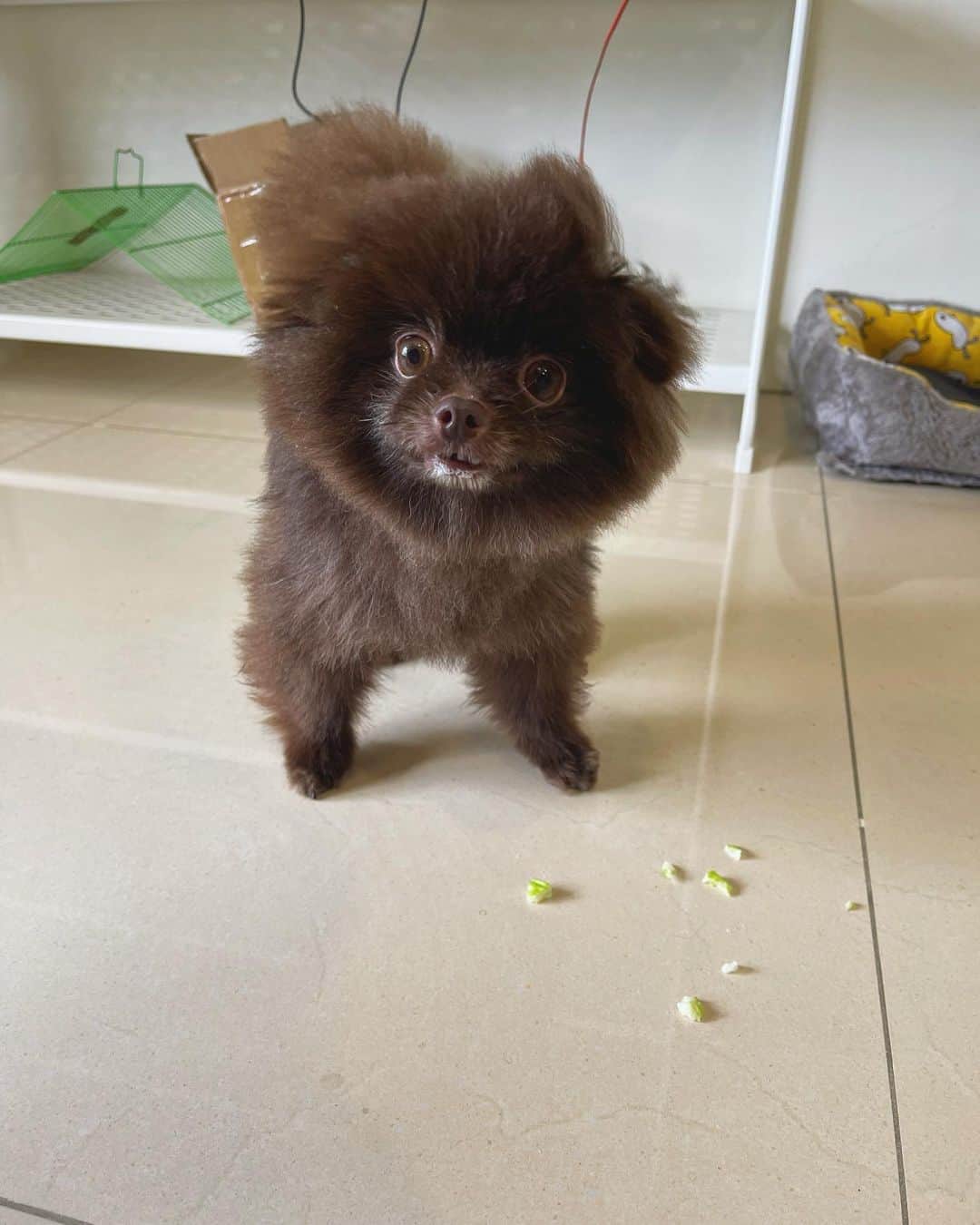
Photo from: @bomwanlife
There are certain shades with a pattern that is becoming increasingly popular among many types of canines, including Poodles, Pitbulls, Corgis, English Bulldogs, and Pomeranians.
When it comes to Pomeranians, the merle pattern is recognized in chocolate and blue shades. The merle gene is dominant, and it can be inherited by both male and female Poms.
This type of marking can leave shades such as pale brown, solid black, or reddish-brown on a chocolate Pomeranian.
Merle chocolate Pomeranians have spots of lighter brown color all over their body, which might make it difficult to recognize the exact color of the pup at first.
When it comes to merle pups, it doesn’t matter whether the pattern and colors will be consistent; the only thing that is important is the shade of the base coat.
2. Blue Merle
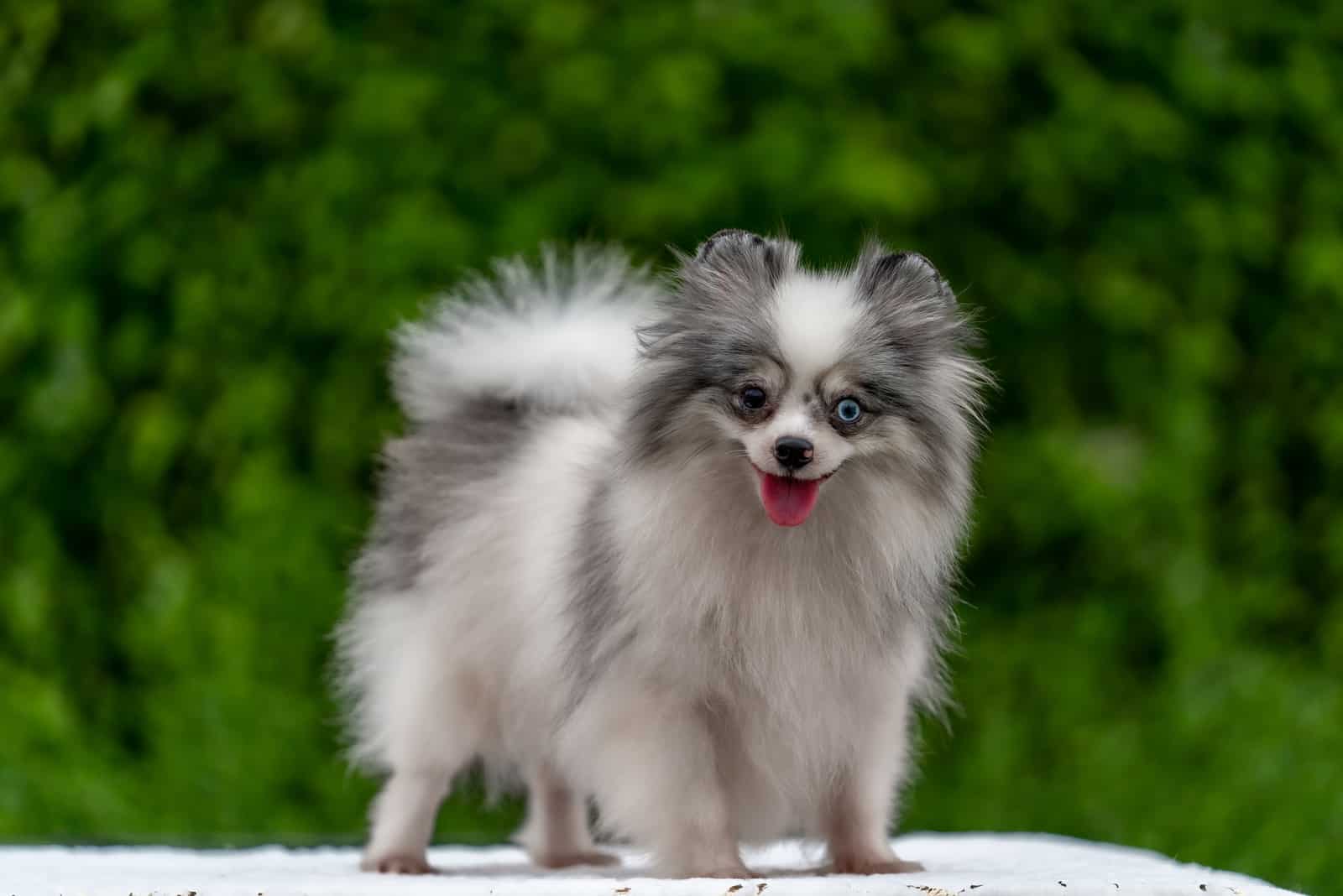
The blue merle Pom is one of the most expensive canines of this breed because of its rare pattern.
Many will agree that this type of coat is actually nothing else but a black Pomeranian with the dilution gene that is active in the black parts of the coat, which provides the distinctive appearance of the canine.
According to the breed standard set by the AKC, blue merle isn’t an official color of this breed, which is why blue merle Pomeranians aren’t allowed to compete in dog shows or conformation events.
The main reason for such a decision is the fear that double merles (bred by two merles) have a high risk of blindness and hearing impairment, which might also result in deafness.
Poms aren’t the only breed that have their coat covered in this color and pattern. Once you see the blue merle Bulldogs, you’ll indeed have a difficult time choosing which one you like more!
3. Merle And Tan
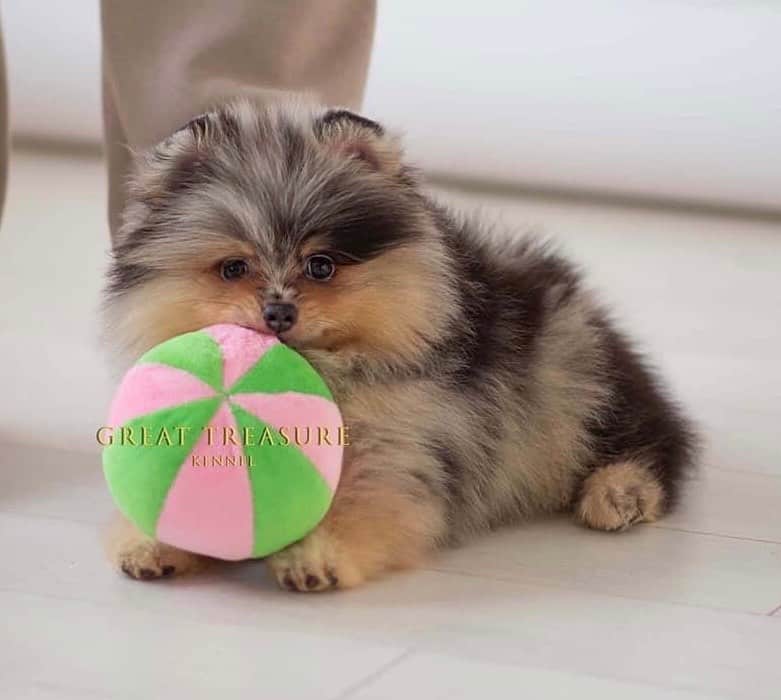
Photo from: @poms.parrots
To be exact, merle Pomeranian canines can possess either a blue or chocolate base coat, with specks in different colors.
In this case, blue and choco merle Poms will have random tan patterns on their topcoat. These spots can be either pale brown, reddish-brown, or even black in some cases.
I guess you might be wondering how different merle and tan pups are from tricolors, and that’s completely understandable.
To solve this issue, it’s enough to say that tri-color Poms are considered a blend of three single hues, while merle and tan pups have randomly-positioned speckles of colors all around the pup’s body.
This is one of the latest coat types that has been recognized by dog owners and breeders. However, institutions such as the AKC, The Kennel Club, United Kennel Club, and certain Pomeranian clubs still don’t acknowledge it as an official color.
4. Blue Brindle
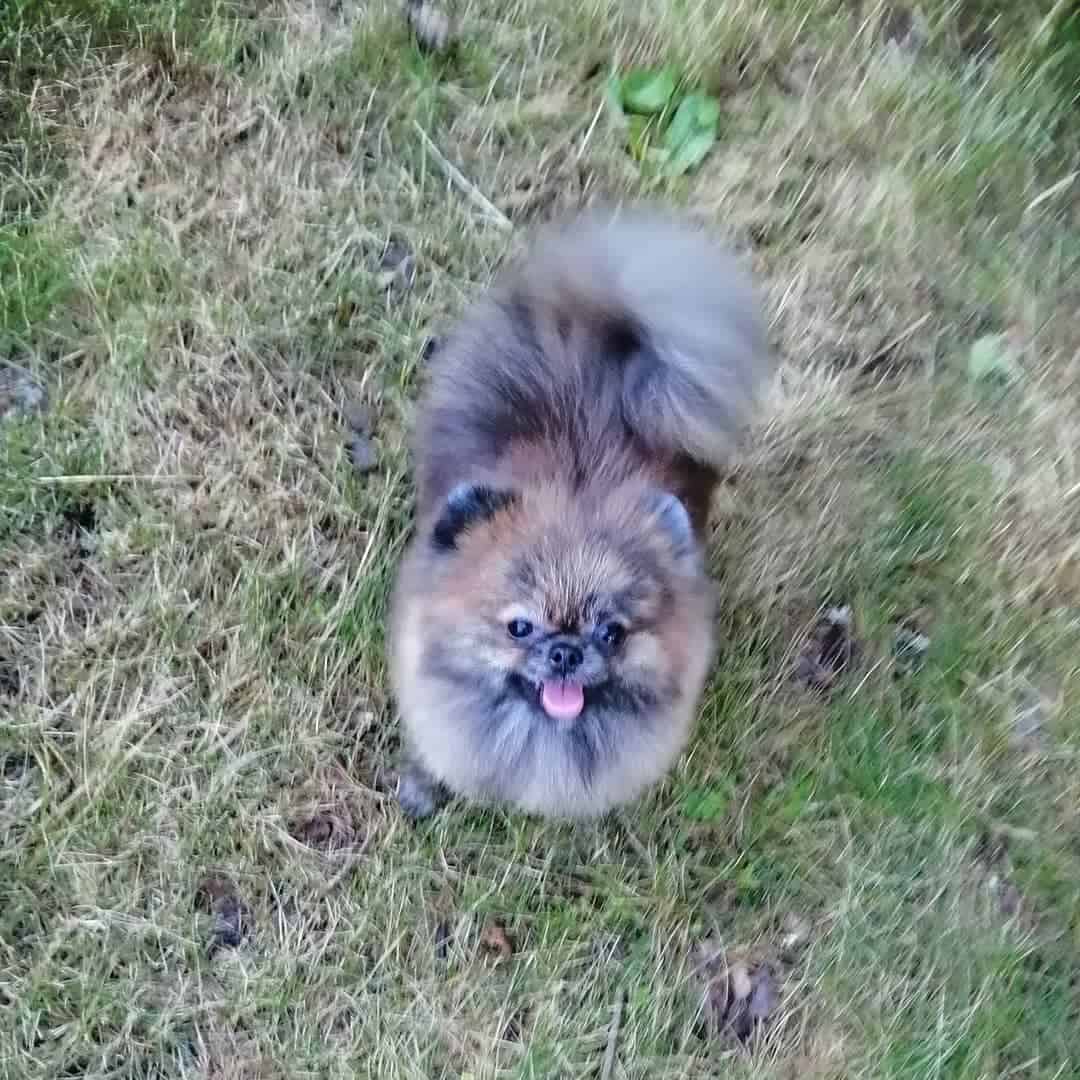
Photo from: @brindle.pomeranian
This type of color resembles the black brindle one in a great manner in terms of the pattern. However, the single distinction is that the blue brindle pattern includes the blue markings rather than the black ones.
The undercoat pigmentation of blue brindle Pomeranians is usually either crimson, orange, or golden.
Because it may appear anywhere from gray to silver, the brindle pattern is notably challenging to identify.
Those interested in whether their brindle Pomeranians are black or blue will have to inspect the lines closely because they can be pretty thin, making them even harder to notice in the Pomeranian’s fluffy coat hair.
5. Black And Brindle
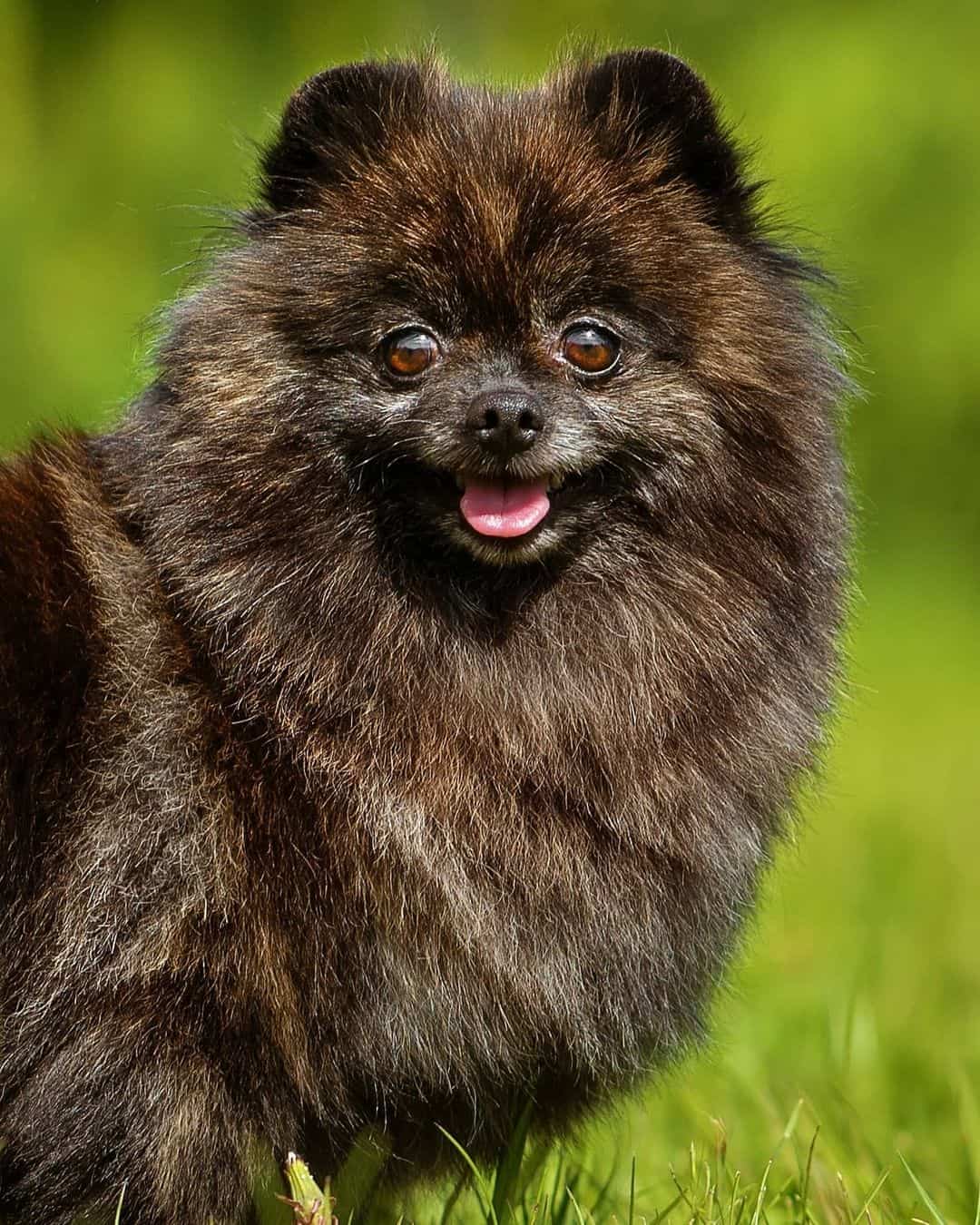
Photo from: @brindle.pomeranian
This type of Pomeranian coat is characterized by a tiger-like pattern that is a mixture of orange, dark red, or golden base shades, along with black lines that appear randomly all over the body.
The shape of the stripes is irregular, which means that they can be anywhere from extremely thin to very dense, depending on the area.
The brindle stripes are sometimes difficult to notice because of the length and density of the coat. The best way to see these stripes is to focus on the head, back, and paws, where they usually appear.
6. Lavender
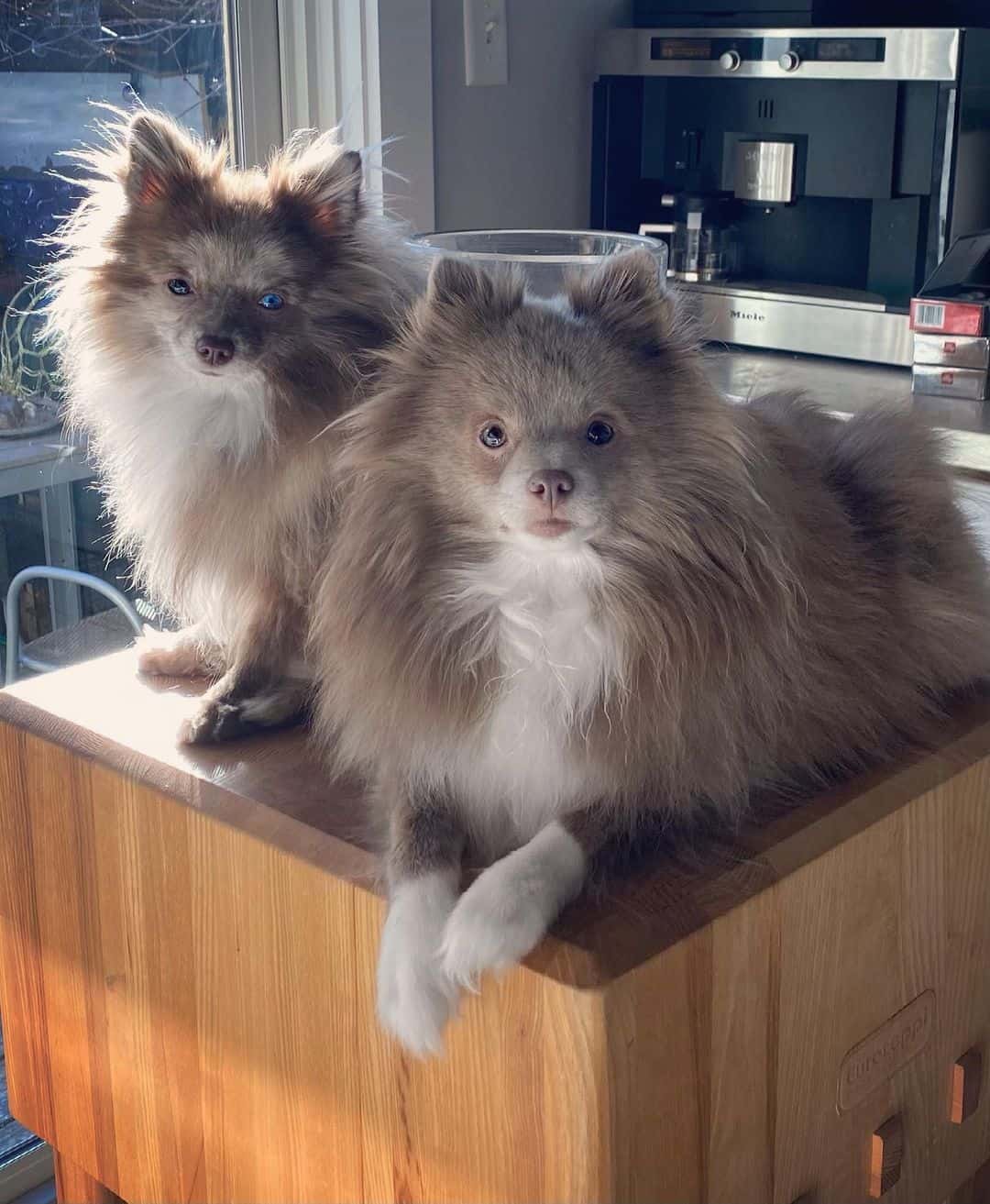
Photo from:@pompomchaka
Lavender Pomeranians are the most unique of all colors and patterns of this dog breed, and they were created as a cross between a beaver and a blue Pom.
Although both parents of Lavender Poms come from the same dog breed, the AKC and other institutions still don’t recognize this shade as an official color of Pomeranians.
The colors of Lavender Poms can go anywhere from bright to deep gray, with a little bit of a lilac or darker purple shade.
Lavender-colored dogs can have a parti combination with white spots, but an exclusively full-colored Pomeranian will never have any speckle of other colors on it.
What are the most common colors of a Pomeranian?
The most common shades of the Pomeranian breed are orange, black, gray, white, and brown (or chocolate).
Essentially, solid colors are the most frequent coat types of Pomeranians because they’re easier to breed than the patterned types, especially those with the recessive gene, such as brindles.
The colors that the AKC acknowledge are more common because they’re not difficult to breed, and they’re accepted in all sorts of conformation events and dog shows.
How Do You Groom A Pomeranian?
This is an excellent question, especially for new owners of Pomeranians who still haven’t had the chance to groom pups with a double coat.
Pomeranians could be described as high-maintenance canines because of all the fluffy hair they have, which needs to be brushed every day if you don’t want to have their hair all over your place.
Therefore, make sure to get a good brush for a doggy with a dense coat, such as the Pomeranian.
Bathing is required every three to four weeks, although I’d suggest you wash your pet once every week or every two weeks because they will get dirty, especially if you take them outside.
If you’re not confident about grooming your Pomeranian at home, you can always go to a professional groomer.
How Do You Groom A Pomeranian At Home?
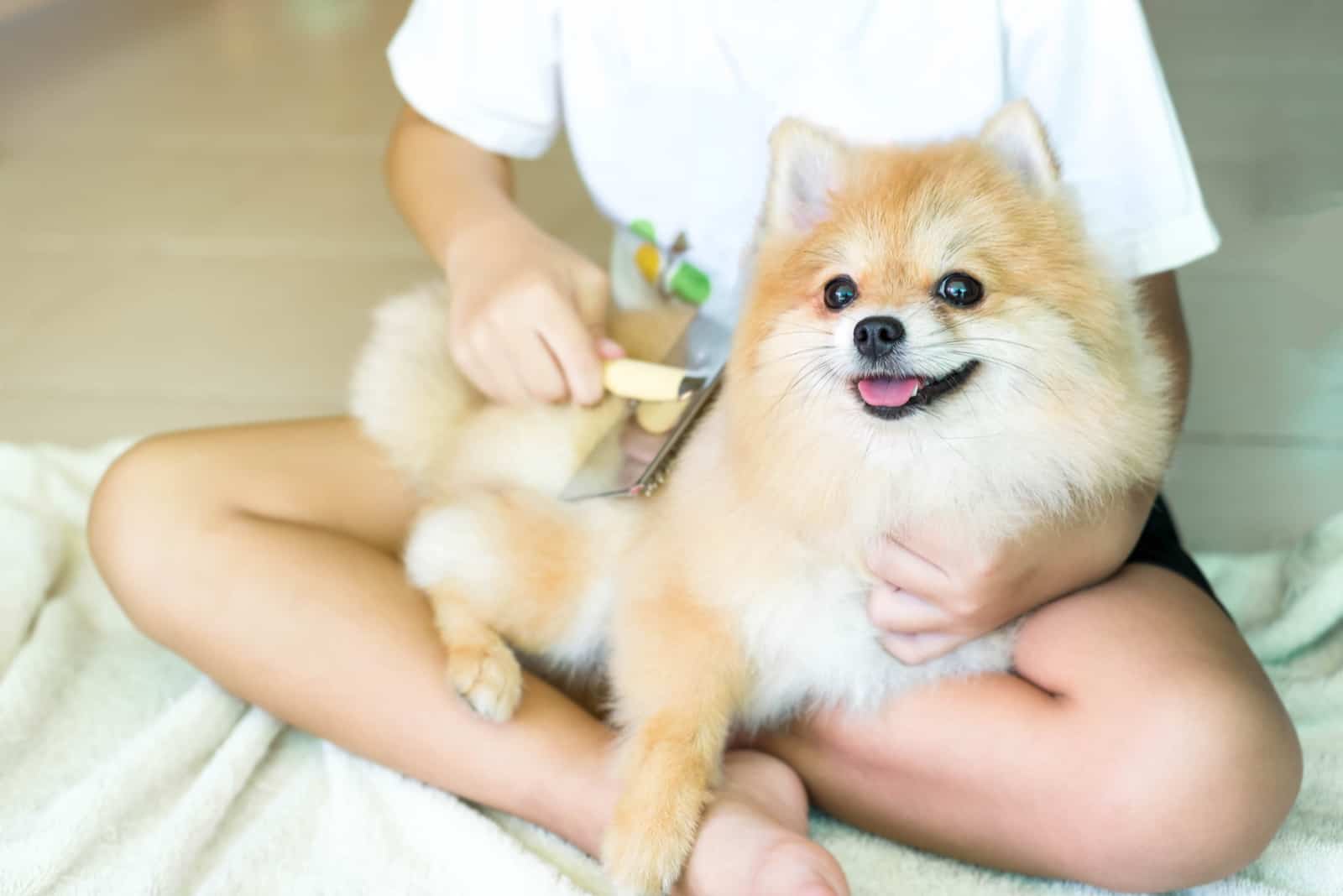
In case you’re ready for the adventure called grooming a high-maintenance canine in your home, here are some tips and tricks that might come in handy.
Brushing
This sounds like a simple step, which it indeed is, but you should be careful about a few things.
First of all, make sure to get the best brushes for Pomeranians, and those are bristle brushes, which won’t hurt your pup and will get rid of all the excessive hair.
The best way to brush a Pom’s hair is by mixing a conditioner (leave-in, of course) with water and spraying the dog’s hair before you start. This step will help you avoid static electricity.
If you can’t brush a tangle, try with a comb. If you still have issues, it’s better to cut them off than leave them or hurt your pup.
Bathing
Bath preparations are just as crucial as the bathing process, especially if you have a pup that’s not a big fan of water, like Pomeranians.
The best way to ensure your canine’s safety is to put a towel or a mat on the bottom of the tub, which will prevent your pup from slipping in case it shows resistance toward the water.
The most important part of this process is avoiding sensitive areas, such as the eyes, ears, and mouth.
A good shampoo and mild conditioner will do wonders on a Pomeranian’s fluffy coat, and will turn it into a soft, fluffy ball of fur.
Make sure to rinse all products from the Pom’s coat, and dry the fur properly so your pet doesn’t get sick.
A Pomeranian’s double coat might be challenging to groom, but their beautiful personality and adorable looks make it all worth it.
Pomeranians shouldn’t be bathed too often because of the natural oil that protects their fur, but they surely need to get bathed more often than Golden Retrievers.
The optimal time is every three to four weeks, even though some experts would recommend it even earlier in case your pup gets dirty quickly.
Ears And Nails
Cleaning your Pomeranian’s ears is a crucial grooming process that will prevent any ear infection, especially since Pomeranians have long coat hair.
Clean your pup’s ears with a cotton swab soaked in a cleanser that doesn’t include any alcohol.
Make sure that the cotton swab doesn’t go too far into the ear canal, or else it might hurt your pup, especially if you make any sudden moves during cleaning.
Also, you should make sure to avoid cleansers that contain alcohol because it might dry out your canine’s skin or cause a sort of skin infection.
How Do You Trim A Canine’s Nails?
The best way to trim your puppy’s nails is by raising its feet from behind and bending the knees so that you can have a good grip.
This is a far simpler alternative than attempting to drag the paw to yourself while you’re sitting in front of your pet.
Make sure that you find the quick and leave a little bit of length (at least a few millimeters), which will guard the quick.
In case you’re wondering why the quick is so important, keep in mind that this part of the paw (nails) is full of nerves and blood vessels.
If you are unable to find the quick, use the clippers to remove very little portions of the nail from the tip of the nail in case the canine has lengthy quicks that might bleed.
Trimming The Hair
Trimming your pet’s hair is much simpler than it seems at first. The majority of new owners decide to take their pet to the groomer even for a slight length change.
However, if you decide to cut your pup’s hair by yourself, there are just a few tips and tricks which might ease the process.
First of all, if your pup hasn’t had a trim so far, you should start training them as soon as possible. A few millimeters will be just enough for a start, so the puppy gets used to the sound of the machine and everything that is going on around him.
While cutting the coat hair, don’t forget to trim away any extra that may be present around the ears, paw pads, eyes, and any other body part with deeper folds.
The Haircut
Along with specific colors, Pomeranians have a unique appearance that makes them look all puffy and adorable!
In order to get that type of look, you should trim all sides almost equally. Don’t forget to cut the area around the ears and the tail as well.
Of course, once you feel ready for new challenges, you can try out different coat hairstyles; I’m sure your pup will look great with each of them.
Last Words
From solid colors to wonderful patterns, there are many Pomeranian colors that make this tiny dog breed even more lovable!
Of course, the colors of the coat aren’t the only thing that is valued about this breed. Pomeranians are known as amiable pups that become great family pets.
This pup won’t have any issue adapting to a new environment, even if it involves other animals. Therefore, these pups are among the best choices for families that already have a pet or two.
These pups might seem high-maintenance, but they will cost you less than larger breeds like Bernese Mountain Dogs, Great Danes, or Germans Shepherds.
I hope this article has helped you choose your perfect pet in any color you may like, whether it is recognized by the AKC or not!
READ NEXT:
Teacup Pomeranian: Breed Information And Ultimate Care Guide
